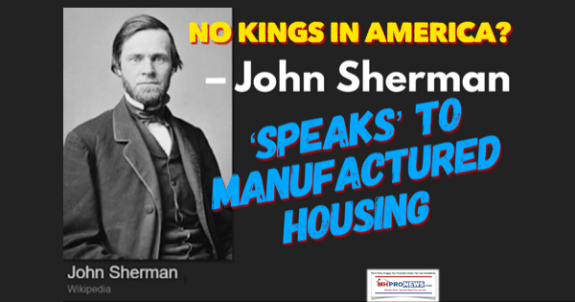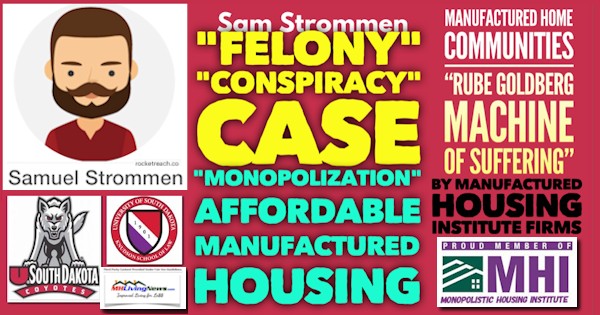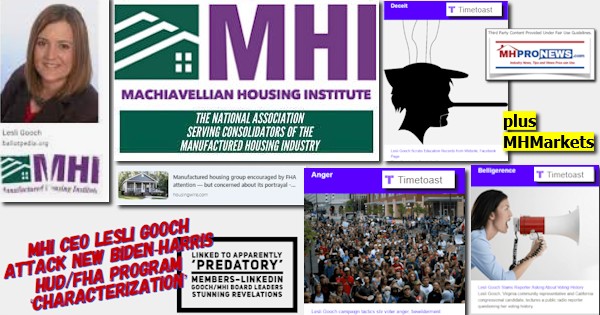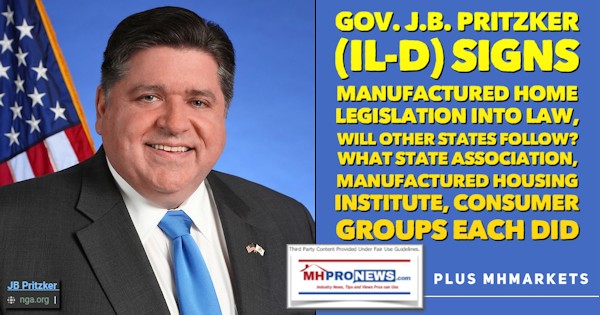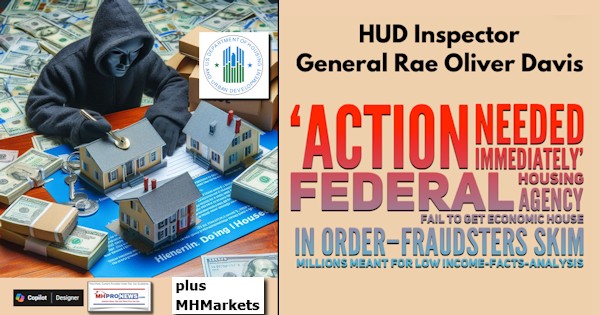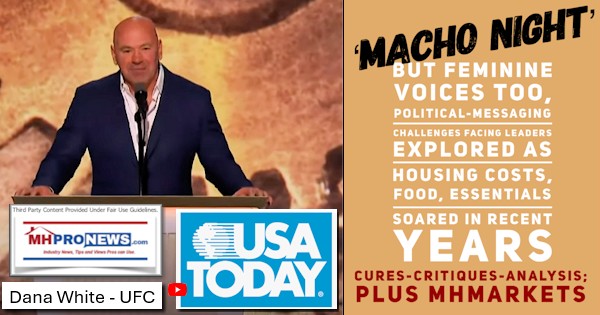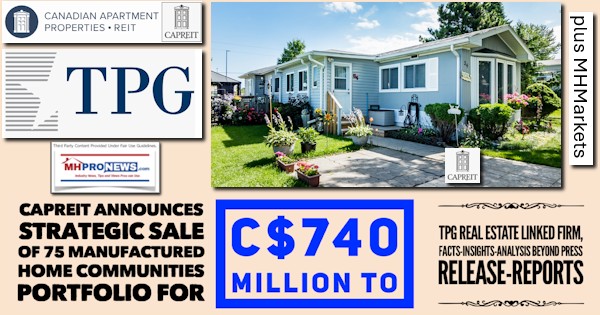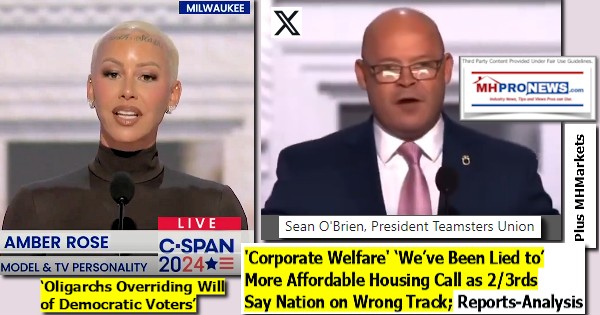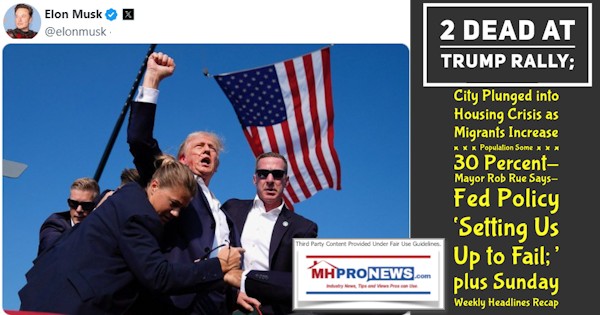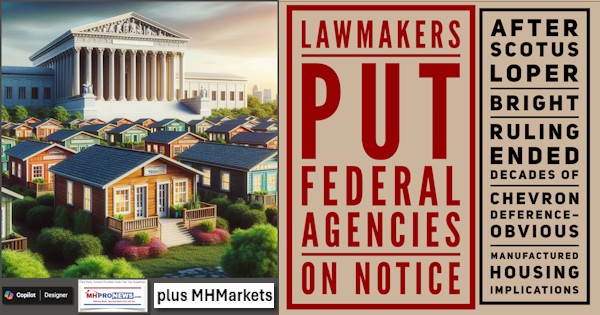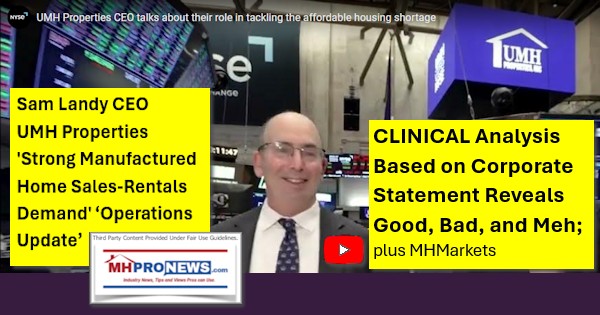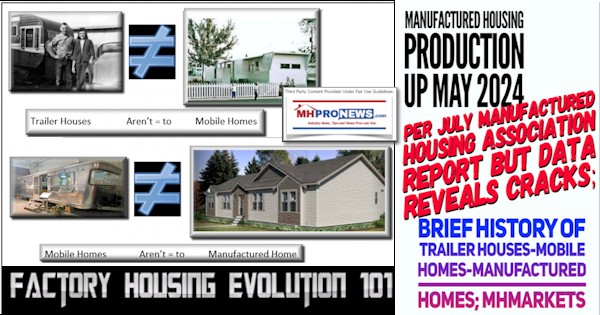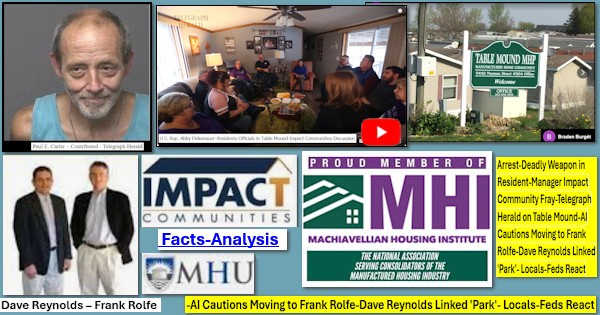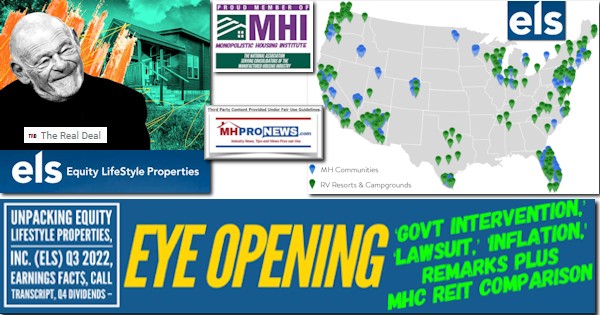
Equity LifeStyle Properties (NYSE-ELS) has produced their usual bevy of information that MHProNews has organized into this single, extensive report with analysis. ELS’ December Dividends, 3rd quarterly financials, and their most recent quarterly earnings call are all found below. Note that billionaire Chairman Sam Zell’s ELS used mega billionaire Chairman Warren Buffett led Berkshire Hathaway (BRK) owned Business Wire to issue their press release. Equity LifeStyle reported increased revenues, higher Funds from Operations (FFOs), and increased operating revenues, among other facts per ELS. Post Hurricane Ian and a range of other guidance are below too. Tucked among the various statements and disclosures are the gems MHProNews identifies for MHVille pros to consider because who else does this level of factual exploration focused on the manufactured housing industry’s apparent 21st century underperformance?
Note that an MS Word search of what follows only uses the word “litigation” once, and not in the manner that some who follow ELS may expect. Similarly, the word “lawsuit” is only mentioned once. But a fascinating topic raised by ELS’s statement below is about government intervention. Then, a Word search reveals 6 mentions of “inflation” by the communities giant, which is a topic that the smaller rival REIT UMH Properties handled quite differently. Those items and more will be part of what the Additional Information, with More MHProNews Facts, Analysis and Commentary will examine.
Highlighting in what follows is added for emphasis of items that may be of interest to the discerning, MHProNews enlightened contrarians. Zell himself preaches a contrarian perspective. The text in highlighted items are as shown per ELS and related source, unless a bracketed comment is added for clarity.
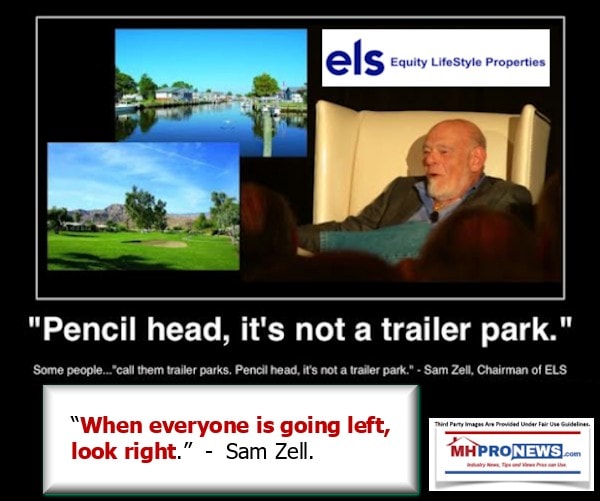
The first of three segments about ELS, per ELS is from Business Wire via Seeking Alpha.
ELS Reports Third Quarter Results
Oct. 17, 2022 4:16 PM ET Equity LifeStyle Properties, Inc. (ELS)
Continued Strong Performance;
Updated Guidance Due To Hurricane Ian

Financial Results for the Quarter and Nine Months Ended September 30, 2022
For the quarter ended September 30, 2022, total revenues increased $33.7 million, or 9.7%, to $381.0 million, compared to $347.2 million for the same period in 2021. For the quarter ended September 30, 2022, net income available for Common Stockholders decreased $3.4 million, to $67.2 million, or $0.36 per Common Share, compared to $70.6 million, or $0.38 per Common Share, for the same period in 2021.
For the nine months ended September 30, 2022, total revenues increased $125.4 million, or 12.8%, to $1,106.5 million, compared to $981.1 million for the same period in 2021. For the nine months ended September 30, 2022, net income available for Common Stockholders increased $14.7 million, or $0.06 per Common Share, to $211.6 million, or $1.14 per Common Share, compared to $196.9 million, or $1.08 per Common Share, for the same period in 2021.
Non-GAAP Financial Measures and Portfolio Performance
For the quarter ended September 30, 2022, Funds from Operations (“FFO”) available for Common Stock and OP Unit holders increased $9.9 million, or $0.04 per Common Share, to $134.4 million, or $0.69 per Common Share, compared to $124.5 million, or $0.65 per Common Share, for the same period in 2021. For the nine months ended September 30, 2022, Funds from Operations available for Common Stock and OP Unit holders increased $34.3 million, or $0.15 per Common Share, to $396.9 million, or $2.03 per Common Share, compared to $362.6 million, or $1.88 per Common Share, for the same period in 2021.
For the quarter ended September 30, 2022, Normalized Funds from Operations (“Normalized FFO”) available for Common Stock and OP Unit holders increased $12.3 million, or $0.05 per Common Share, to $136.8 million, or $0.70 per Common Share, compared to $124.5 million, or $0.65 per Common Share, for the same period in 2021. For the nine months ended September 30, 2022, Normalized Funds from Operations available for Common Stock and OP Unit holders increased $38.1 million, or $0.17 per Common Share, to $403.5 million, or $2.07 per Common Share, compared to $365.4 million, or $1.90 per Common Share, for the same period in 2021.
For the quarter ended September 30, 2022, property operating revenues, excluding deferrals, increased $24.1 million to $332.8 million, compared to $308.7 million for the same period in 2021. For the nine months ended September 30, 2022, property operating revenues, excluding deferrals, increased $81.9 million to $971.0 million, compared to $889.1 million for the same period in 2021. For the quarter ended September 30, 2022, income from property operations, excluding deferrals and property management, increased $11.1 million to $183.9 million, compared to $172.8 million for the same period in 2021. For the nine months ended September 30, 2022, income from property operations, excluding deferrals and property management, increased $41.6 million to $551.2 million, compared to $509.6 million for the same period in 2021.
For the quarter ended September 30, 2022, Core property operating revenues, excluding deferrals, increased approximately 5.3% and Core income from property operations, excluding deferrals and property management, increased approximately 3.5%, compared to the same period in 2021. For the nine months ended September 30, 2022, Core property operating revenues, excluding deferrals, increased approximately 6.5% and Core income from property operations, excluding deferrals and property management, increased approximately 5.3%, compared to the same period in 2021.
Business Updates
Pages 1 and 2 of this Earnings Release and Supplemental Financial Information provide an update on operations, Hurricane Ian and 2022 guidance.
Investment Activity
In July 2022, we continued our partnership with RVC Outdoor Destinations and acquired an 80% equity interest in a joint venture for a total value of $1.1 million. The joint venture owns one property under development located in Gulf Shores, Alabama.
During the third quarter, we completed the acquisition of two parcels of land adjacent to two of our MH properties for an aggregate purchase price of $7.3 million.
About Equity LifeStyle Properties
We are a self-administered, self-managed real estate investment trust (“REIT”) with headquarters in Chicago. As of October 17, 2022, we own or have an interest in 445 quality properties in 35 states and British Columbia consisting of 170,245 sites.
For additional information, please contact our Investor Relations Department at (800) 247-5279 or at investor_relations@equitylifestyle.com.
Conference Call
A live webcast of our conference call discussing these results will take place tomorrow, Tuesday, October 18, 2022, at 10:00 a.m. Central Time. Please visit the Investor Relations section at www.equitylifestyleproperties.com for the link. A replay of the webcast will be available for two weeks at this site. [MHProNews Note: that earnings call transcript is found below].
Forward-Looking Statements
In addition to historical information, this press release includes certain “forward-looking statements” within the meaning of the Private Securities Litigation Reform Act of 1995. When used, words such as “anticipate,” “expect,” “believe,” “project,” “intend,” “may be” and “will be” and similar words or phrases, or the negative thereof, unless the context requires otherwise, are intended to identify forward-looking statements and may include without limitation, information regarding our expectations, goals or intentions regarding the future, and the expected effect of our acquisitions. These forward-looking statements are subject to numerous assumptions, risks and uncertainties, including, but not limited to:
- our ability to control costs and real estate market conditions, our ability to retain customers, the actual use of sites by customers and our success in acquiring new customers at our properties (including those that we may acquire);
- our ability to maintain historical or increase future rental rates and occupancy with respect to properties currently owned or that we may acquire;
- our ability to attract and retain customers entering, renewing and upgrading membership subscriptions;
- our assumptions about rental and home sales markets;
- our assumptions and guidance concerning Net Income, FFO and Normalized FFO per share data;
- our ability to manage counterparty risk;
- our ability to renew our insurance policies at existing rates and on consistent terms;
- home sales results could be impacted by the ability of potential homebuyers to sell their existing residences as well as by financial, credit and capital markets volatility;
- results from home sales and occupancy will continue to be impacted by local economic conditions, including an adequate supply of homes at reasonable costs, lack of affordable manufactured home financing and competition from alternative housing options including site-built single-family housing;
- impact of government intervention to stabilize site-built single-family housing and not manufactured housing;
- effective integration of recent acquisitions and our estimates regarding the future performance of recent acquisitions;
- the completion of future transactions in their entirety, if any, and timing and effective integration with respect thereto;
- unanticipated costs or unforeseen liabilities associated with recent acquisitions;
- the effect of Hurricane Ian on our business including, but not limited to the following: (i) the timing and cost of recovery, (ii) the impact of the condition of properties and homes on occupancy demand and related rent revenue and (iii) the timing and amount of insurance proceeds;
- our ability to obtain financing or refinance existing debt on favorable terms or at all;
- the effect of inflation and interest rates;
- the effect from any breach of our, or any of our vendors’ data management systems;
- the dilutive effects of issuing additional securities;
- the outcome of pending or future lawsuits or actions brought by or against us, including those disclosed in our filings with the Securities and Exchange Commission; and
- other risks indicated from time to time in our filings with the Securities and Exchange Commission.
Our guidance acknowledges the existence of volatile economic conditions, which may impact our current guidance assumptions. Factors impacting 2022 guidance include, but are not limited to the following: (i) the mix of site usage within the portfolio; (ii) yield management on our short-term resort and marina sites; (iii) scheduled or implemented rate increases on community, resort and marina sites; (iv) scheduled or implemented rate increases in annual payments under membership subscriptions; (v) occupancy changes; (vi) our ability to attract and retain membership customers; (vii) change in customer demand regarding travel and outdoor vacation destinations; (viii) our ability to manage expenses in an inflationary environment; (ix) our ability to integrate and operate recent acquisitions in accordance with our estimates; (x) our ability to execute expansion/development opportunities in the face of supply chain delays/shortages; (xi) completion of pending transactions in their entirety and on assumed schedule; (xii) our ability to attract and retain property employees, particularly seasonal employees; (xiii) ongoing legal matters and related fees,/span>; and (xiv) costs to restore property operations and potential revenue losses following storms or other unplanned events. In addition, these forward-looking statements, including our 2022 guidance are subject to risks related to the COVID-19 pandemic, many of which are unknown, including the duration of the pandemic, the extent of the adverse health impact on the general population and on our residents, customers and employees in particular, its impact on the employment rate and the economy, the extent and impact of governmental responses and the impact of operational changes we have implemented and may implement in response to the pandemic.
For further information on these and other factors that could impact us and the statements contained herein, refer to our filings with the Securities and Exchange Commission, including the “Risk Factors” section in our most recent Annual Report on Form 10-K and subsequent quarterly reports on Form 10-Q.
These forward-looking statements are based on management’s present expectations and beliefs about future events. As with any projection or forecast, these statements are inherently susceptible to uncertainty and changes in circumstances. We are under no obligation to, and expressly disclaim any obligation to, update or alter our forward-looking statements whether as a result of such changes, new information, subsequent events or otherwise.
Supplemental Financial Information
| Operations Update |
Normalized FFO per Common Share
- Third Quarter (“Q3”) 2022: $0.70 or 8.5% growth compared to the same period in 2021.
- September Year to Date (“YTD”) 2022: $2.07 or 9.0% growth compared to the same period in 2021.
Core Income from property operations, excluding deferrals and property management
- Q3 2022: 3.5% growth compared to the same period in 2021.
- September YTD 2022: 5.3% growth compared to the same period in 2021.
REVENUES
MH – 60% of Total Property Operating Revenues
- Q3 2022 Core MH base rental income: 5.9% growth compared to the same period in 2021, which reflects 5.5% growth from rate increases and 0.4% from occupancy gains.
- September YTD 2022 Core MH base rental income: 5.7% growth compared to the same period in 2021, which reflects 5.3% growth from rate increases and 0.4% from occupancy gains.
- September YTD 2022 Core MH occupancy increased by 119 sites since December 31, 2021.
- September YTD 2022 Core Manufactured homeowners increased by 633 since December 31, 2021.
- Q3 2022 New home sales: 331 sales with an average sales price of $106,000.
- By October month-end, we anticipate sending 2023 rent increase notices to approximately 51% of our MH residents. These rent increases will be effective by February 1, 2023 and have an average growth rate in the range of 6.2% to 6.6%.
RV and Marina – 32% of Total Property Operating Revenues
- Q3 2022 Core RV and marina base rental income: 4.1% growth compared to the same period in 2021.
- September YTD 2022 Core RV and marina base rental income: 10.3% growth compared to the same period in 2021.
- Q3 2022 Core RV annual base rental income: 8.7% growth compared to the same period in 2021, which reflects 6.6% growth from rate increases and 2.1% from occupancy gains.
- Q3 2022 combined Core Seasonal and Transient RV base rental income: exceeded our previously provided guidance with a decline of 2.0% from the same period in 2021 as a result of better than expected Seasonal rental income.
- September YTD 2022 combined Core Seasonal and Transient RV base rental income: increased 13.0% or $12.5 million over the same period in 2021.
- Core RV Site Composition
| September 30, 2022 | September 30, 2021 | ||
| Annual | 32,200 | 31,600 | |
| Seasonal | 12,100 | 10,700 | |
| Transient | 12,200 | 13,800 | |
| Member | 25,400 | 24,800 |
- Third quarter total nights camped increased 1.8% and 7.4% compared to the quarters ended September 30, 2021 and September 30, 2019, respectively.
- We have set RV annual rates for the 2023 season for 95% of our annual sites. These rate increases will take effect between November 1, 2022 and April 1, 2023 and have an average growth rate in the range of 7.6% to 8.0%.
EXPENSES
Utility Expense – 27% of Total Property Operating Expenses
- The increase in Utility expense was driven by average electric rate increases of 14% in Q3 2022 and 11% for September YTD 2022 compared to the same periods in 2021. The RV properties, which generate lower expense recovery due to the Transient component of the business, experienced the highest rate increases in the quarter with increases in the Northeast and South ranging from 16% to 29%.
| Hurricane Ian Update and 2022 Guidance (1) |
Hurricane Ian Update
Hurricane Ian made landfall on the west coast of Florida on September 28, 2022. Approximately 60% of our Florida portfolio was in the path of the storm as it moved across the state. During the storm, we prioritized the safety of our residents, guests and employees. For the majority of our properties the impact was limited to flooding, wind, wind-blown debris and falling trees and branches. These properties have resumed operations.
The most significant damage to our properties occurred in or near the Fort Myers area. Six of our properties in or near this market continue to experience utility disruptions and are temporarily closed. The properties include four RV parks and two marinas with a total of 2,100 sites/slips. During the storm, the four RV properties experienced strong winds as well as significant flooding, including from unprecedented storm surges that resulted in damage to certain common area buildings, utility infrastructure and residents’ homes. The two marinas suffered wind related building damage and the process of restoring the buildings has begun. We currently expect these properties will resume operations during the fourth quarter, although certain locations may operate at a limited capacity.
Over the last 20 days, we have worked towards quickly returning our properties to full operating condition with efforts focused on debris cleanup and removal and initiating the process to restore impacted buildings and infrastructure. Based on our prior experience with recovery following major storms, developing restoration plans and estimating costs to execute on those plans takes time, often several weeks. We did not record any expenses related to property damage and restoration work during the third quarter of 2022 given the short period of time between the storm’s passage and the end of the reporting period.
We have reviewed our assets impacted by the storm for potential impairment and determined that the estimated future cash flows are greater than the net book value of the assets. As such, it is appropriate not to impair any assets based on our recoverability tests. As part of our review and based on information currently available, we have determined that storm-related damage to certain assets supported a $3.7 million reduction to the carrying value of those assets, which is included in Loss on sale of real estate and impairment, net in the Consolidated Statements of Income on page 6. We believe the costs to restore these damaged assets will be included in our insurance claim.
2022 Guidance
Our updated per share guidance for 2022 Net Income, FFO and Normalized FFO is presented below. We have withdrawn our previously provided full year Core guidance for revenue, expense and NOI for the following reasons:
- The recency of the Hurricane Ian storm event;
- The status of our ongoing assessment of the storm’s impact on our properties; and
- The uncertainty with respect to property operating revenues and expenses for the affected properties as we resume full operations following the storm.
The updated guidance does not include an assumption that we will receive insurance reimbursement for losses resulting from business interruption in 2022. In accordance with GAAP, insurance reimbursement for business interruption losses is to be recognized as revenue upon receipt. At this time, we do not have an estimate of the total potential clean up and restoration costs. We believe we have adequate insurance coverage, subject to deductibles, including business interruption, though we are unable to predict the timing or amount of insurance recovery.
| ($ in millions except per share) | Full Year | |
| Net Income/share | $1.46 to $1.52 | |
| FFO/share | $2.60 to $2.66 | |
| Normalized FFO/share | $2.64 to $2.70 | |
______________________
(1) Full year 2022 guidance ranges represent a range of possible outcomes and the midpoint reflects management’s estimate of the most likely outcome. Actual growth rates and per share amounts could vary materially from growth rates and per share amounts presented above if any of our assumptions, including occupancy and rate changes, our ability to manage expenses in an inflationary environment, our ability to integrate and operate recent acquisitions and costs to restore property operations and potential revenue losses following storms or other unplanned events, is incorrect. See Forward-Looking Statements in this release for additional factors impacting our 2022 guidance assumptions.
| Investor Information |
| Equity Research Coverage(1) | ||
| Bank of America Securities | Barclays | BMO Capital Markets |
| Jeffrey Spector/Joshua Dennerlein | Anthony Powell | John Kim |
| Citi Research | Colliers Securities | Evercore ISI |
| Nick Joseph | David Toti | Steve Sakwa/Samir Khanal |
| Green Street Advisors | RBC Capital Markets | Robert W. Baird & Company |
| John Pawlowski | Brad Heffern | Wes Golladay |
| Truist | UBS | Wolfe Research |
| Anthony Hau | Michael Goldsmith | Andrew Rosivach/Keegan Carl |
______________________
- Any opinions, estimates or forecasts regarding our performance made by these analysts or agencies do not represent our opinions, forecasts or predictions. We do not, by reference to these firms, imply our endorsement of or concurrence with such information, conclusions or recommendations.
| Financial Highlights |
(In millions, except Common Shares and OP Units outstanding and per share data, unaudited)
| As of and for the Quarter Ended | |||||||||||||||
| Sep 30, 2022 | Jun 30, 2022 | Mar 31, 2022 | Dec 31, 2021 | Sept 30, 2021 | |||||||||||
| Operating Information | |||||||||||||||
| Total revenues | $ | 381.0 | $ | 365.3 | $ | 360.2 | $ | 335.3 | $ | 347.2 | |||||
| Net income | $ | 70.5 | $ | 64.6 | $ | 87.1 | $ | 68.8 | $ | 74.1 | |||||
| Net income available for Common Stockholders | $ | 67.2 | $ | 61.5 | $ | 82.9 | $ | 65.5 | $ | 70.6 | |||||
| Adjusted EBITDAre (1) | $ | 166.4 | $ | 153.3 | $ | 168.4 | $ | 150.7 | $ | 150.8 | |||||
| FFO available for Common Stock and OP Unit holders (1)(2) | $ | 134.4 | $ | 121.6 | $ | 140.9 | $ | 123.0 | $ | 124.5 | |||||
| Normalized FFO available for Common Stock and OP Unit holders (1)(2) | $ | 136.8 | $ | 125.3 | $ | 141.4 | $ | 123.6 | $ | 124.5 | |||||
| Funds Available for Distribution (“FAD”) for Common Stock and OP Unit holders (1)(2) | $ | 115.4 | $ | 103.6 | $ | 125.1 | $ | 102.3 | $ | 106.1 | |||||
| Common Shares and OP Units Outstanding (In thousands) and Per Share Data | |||||||||||||||
| Common Shares and OP Units, end of the period | 195,380 | 195,373 | 195,303 | 194,946 | 192,852 | ||||||||||
| Weighted average Common Shares and OP Units outstanding – Fully Diluted | 195,269 | 195,227 | 195,246 | 193,412 | 192,736 | ||||||||||
| Net income per Common Share – Fully Diluted (3) | $ | 0.36 | $ | 0.33 | $ | 0.45 | $ | 0.36 | $ | 0.38 | |||||
| FFO per Common Share and OP Unit – Fully Diluted | $ | 0.69 | $ | 0.62 | $ | 0.72 | $ | 0.64 | $ | 0.65 | |||||
| Normalized FFO per Common Share and OP Unit – Fully Diluted | $ | 0.70 | $ | 0.64 | $ | 0.72 | $ | 0.64 | $ | 0.65 | |||||
| Dividends per Common Share | $ | 0.4100 | $ | 0.4100 | $ | 0.4100 | $ | 0.3625 | $ | 0.3625 | |||||
| Balance Sheet | |||||||||||||||
| Total assets | $ | 5,405 | $ | 5,400 | $ | 5,265 | $ | 5,308 | $ | 4,982 | |||||
| Total liabilities | $ | 3,886 | $ | 3,878 | $ | 3,734 | $ | 3,822 | $ | 3,673 | |||||
| Market Capitalization | |||||||||||||||
| Total debt (4) | $ | 3,329 | $ | 3,298 | $ | 3,193 | $ | 3,303 | $ | 3,154 | |||||
| Total market capitalization (5) | $ | 15,607 | $ | 17,066 | $ | 18,130 | $ | 20,392 | $ | 18,216 | |||||
| Ratios | |||||||||||||||
| Total debt / total market capitalization | 21.3 | % | 19.3 | % | 17.6 | % | 16.2 | % | 17.3 | % | |||||
| Total debt / Adjusted EBITDAre (6) | 5.2 | 5.3 | 5.2 | 5.6 | 5.5 | ||||||||||
| Interest coverage (7) | 5.7 | 5.7 | 5.7 | 5.5 | 5.5 | ||||||||||
| Fixed charges(8) | 5.6 | 5.6 | 5.6 | 5.5 | 5.4 | ||||||||||
________________
- See Non-GAAP Financial Measures Definitions and Reconciliations at the end of the supplemental financial information for definitions of Adjusted EBITDAre, FFO, Normalized FFO and FAD and a reconciliation of Consolidated net income to Adjusted EBITDAre.
- See page 9 for a reconciliation of Net income available for Common Stockholders to Non-GAAP financial measures FFO available for Common Stock and OP Unit holders, Normalized FFO available for Common Stock and OP Unit holders and FAD for Common Stock and OP Unit holders.
- Net income per Common Share – Fully Diluted is calculated before Income allocated to non-controlling interest – Common OP Units.
- Excludes deferred financing costs of approximately $29.0 million as of September 30, 2022.
- See page 17 for the calculation of market capitalization as of September 30, 2022.
- Calculated using trailing twelve months Adjusted EBITDAre.
- Calculated by dividing trailing twelve months Adjusted EBITDAre by the interest expense incurred during the same period.
- See Non-GAAP Financial Measures Definitions and Reconciliations at the end of the supplemental financial information for a definition of fixed charges. This ratio is calculated by dividing trailing twelve months Adjusted EBITDAre by the sum of fixed charges and preferred stock dividends, if any, during the same period.
| Consolidated Balance Sheets |
(In thousands, except share and per share data)
| September 30, 2022 | December 31, 2021 | ||||||
| (unaudited) | |||||||
| Assets | |||||||
| Investment in real estate: | |||||||
| Land | $ | 2,080,234 | $ | 2,019,787 | |||
| Land improvements | 4,083,036 | 3,912,062 | |||||
| Buildings and other depreciable property | 1,139,755 | 1,057,215 | |||||
| 7,303,025 | 6,989,064 | ||||||
| Accumulated depreciation | (2,246,214 | ) | (2,103,774 | ) | |||
| Net investment in real estate | 5,056,811 | 4,885,290 | |||||
| Cash and restricted cash | 30,510 | 123,398 | |||||
| Notes receivable, net | 44,653 | 39,955 | |||||
| Investment in unconsolidated joint ventures | 88,352 | 70,312 | |||||
| Deferred commission expense | 50,029 | 47,349 | |||||
| Other assets, net | 135,091 | 141,567 | |||||
| Total Assets | $ | 5,405,446 | $ | 5,307,871 | |||
| Liabilities and Equity | |||||||
| Liabilities: | |||||||
| Mortgage notes payable, net | $ | 2,708,751 | $ | 2,627,783 | |||
| Term loan, net | 496,595 | 297,436 | |||||
| Unsecured line of credit | 94,984 | 349,000 | |||||
| Accounts payable and other liabilities | 184,771 | 172,285 | |||||
| Deferred membership revenue | 195,290 | 176,439 | |||||
| Accrued interest payable | 10,317 | 9,293 | |||||
| Rents and other customer payments received in advance and security deposits | 115,035 | 118,696 | |||||
| Distributions payable | 80,314 | 70,768 | |||||
| Total Liabilities | 3,886,057 | 3,821,700 | |||||
| Equity: | |||||||
| Preferred stock, $0.01 par value, 10,000,000 shares authorized as of September 30, 2022 and December 31, 2021; none issued and outstanding. | — | — | |||||
| Common stock, $0.01 par value, 600,000,000 shares authorized as of September 30, 2022 and December 31, 2021; 186,108,851 and 185,640,379 shares issued and outstanding as of September 30, 2022 and December 31, 2021, respectively. | 1,916 | 1,913 | |||||
| Paid-in capital | 1,625,751 | 1,593,362 | |||||
| Distributions in excess of accumulated earnings | (200,969 | ) | (183,689 | ) | |||
| Accumulated other comprehensive income | 20,476 | 3,524 | |||||
| Total Stockholders’ Equity | 1,447,174 | 1,415,110 | |||||
| Non-controlling interests – Common OP Units | 72,215 | 71,061 | |||||
| Total Equity | 1,519,389 | 1,486,171 | |||||
| Total Liabilities and Equity | $ | 5,405,446 | $ | 5,307,871 | |||
| Consolidated Statements of Income |
(In thousands, unaudited)
| Quarters Ended September 30, | Nine Months Ended September 30, | ||||||||||||||
| 2022 | 2021 | 2022 | 2021 | ||||||||||||
| Revenues: | |||||||||||||||
| Rental income. | $ | 289,016 | $ | 269,573 | $ | 849,411 | $ | 774,293 | |||||||
| Annual membership subscriptions | 16,254 | 15,127 | 47,003 | 43,048 | |||||||||||
| Membership upgrade sales current period, gross | 11,085 | 10,122 | 27,771 | 29,343 | |||||||||||
| Membership upgrade sales upfront payments, deferred, net | (7,777 | ) | (7,253 | ) | (18,228 | ) | (21,134 | ) | |||||||
| Other income | 15,580 | 12,053 | 43,316 | 36,759 | |||||||||||
| Gross revenues from home sales, brokered resales and ancillary services (1) | 52,547 | 44,570 | 144,937 | 110,048 | |||||||||||
| Interest income. | 1,865 | 1,805 | 5,346 | 5,314 | |||||||||||
| Income from other investments, net | 2,399 | 1,238 | 6,920 | 3,396 | |||||||||||
| Total revenues | 380,969 | 347,235 | 1,106,476 | 981,067 | |||||||||||
| Expenses: | |||||||||||||||
| Property operating and maintenance | 123,181 | 109,164 | 341,480 | 300,700 | |||||||||||
| Real estate taxes | 17,734 | 18,408 | 56,373 | 54,154 | |||||||||||
| Sales and marketing, gross | 7,143 | 6,513 | 18,466 | 18,987 | |||||||||||
| Membership sales commissions, deferred, net | (1,206 | ) | (1,468 | ) | (2,746 | ) | (4,405 | ) | |||||||
| Property management | 19,003 | 17,015 | 55,973 | 48,955 | |||||||||||
| Depreciation and amortization | 52,547 | 44,414 | 152,737 | 138,127 | |||||||||||
| Cost of home sales, brokered resales and ancillary services (1) | 40,224 | 34,830 | 111,894 | 85,541 | |||||||||||
| Home selling expenses and ancillary operating expenses (1) | 7,080 | 6,558 | 21,146 | 17,588 | |||||||||||
| General and administrative | 11,086 | 10,401 | 35,078 | 31,141 | |||||||||||
| Other expenses | 1,627 | 797 | 6,636 | 2,295 | |||||||||||
| Early debt retirement | — | — | 1,156 | 2,784 | |||||||||||
| Interest and related amortization | 29,759 | 27,361 | 85,276 | 80,767 | |||||||||||
| Total expenses | 308,178 | 273,993 | 883,469 | 776,634 | |||||||||||
| Loss on sale of real estate and impairment, net (2) | (3,747 | ) | — | (3,747 | ) | (59 | ) | ||||||||
| Income before equity in income of unconsolidated joint ventures | 69,044 | 73,242 | 219,260 | 204,374 | |||||||||||
| Equity in income of unconsolidated joint ventures | 1,465 | 851 | 2,889 | 2,786 | |||||||||||
| Consolidated net income | 70,509 | 74,093 | 222,149 | 207,160 | |||||||||||
| Income allocated to non-controlling interests – Common OP Units | (3,346 | ) | (3,468 | ) | (10,563 | ) | (10,236 | ) | |||||||
| Redeemable perpetual preferred stock dividends | — | — | (8 | ) | (8 | ) | |||||||||
| Net income available for Common Stockholders | $ | 67,163 | $ | 70,625 | $ | 211,578 | $ | 196,916 | |||||||
______________________
- Prior period amounts have been reclassified to conform to the current period presentation.
- Reflects a $3.7 million reduction to the carrying value of certain assets, including home inventory as a result of Hurricane Ian for the quarter and nine months ended September 30, 2022.
Non-GAAP Financial Measures
This document contains certain non-GAAP measures used by management that we believe are helpful to understand our business. We believe investors should review these non-GAAP measures along with GAAP net income and cash flows from operating activities, investing activities and financing activities, when evaluating an equity REIT’s operating performance. Our definitions and calculations of these non-GAAP financial and operating measures and other terms may differ from the definitions and methodologies used by other REITs and, accordingly, may not be comparable. These non-GAAP financial and operating measures do not represent cash generated from operating activities in accordance with GAAP, nor do they represent cash available to pay distributions and should not be considered as an alternative to net income, determined in accordance with GAAP, as an indication of our financial performance, or to cash flows from operating activities, determined in accordance with GAAP, as a measure of our liquidity, nor are they indicative of funds available to fund our cash needs, including our ability to make cash distributions. For definitions and reconcilitions of non-GAAP measures to our financial statements as prepared under GAAP, refer to both Reconciliation of Net Income to Non-GAAP Financial Measures on page 9 and Non-GAAP Financial Measures Definitions and Reconciliations on pages 19- 21.
| Selected Non-GAAP Financial Measures |
(In millions, except per share data, unaudited)
| Quarter Ended | |||
| September 30, 2022 | |||
| Income from property operations, excluding deferrals and property management – 2022 Core (1) | $ | 173.1 | |
| Income from property operations, excluding deferrals and property management – Non-Core (1) | 10.8 | ||
| Property management and general and administrative | (30.1 | ) | |
| Other income and expenses (excluding transaction/pursuit costs) | 12.8 | ||
| Interest and related amortization | (29.8 | ) | |
| Normalized FFO available for Common Stock and OP Unit holders (2) | $ | 136.8 | |
| Transaction/pursuit costs (3) | (0.3 | ) | |
| Lease termination expenses (4) | (2.1 | ) | |
| FFO available for Common Stock and OP Unit holders (2) | $ | 134.4 | |
| FFO per Common Share and OP Unit – Fully Diluted | $ | 0.69 | |
| Normalized FFO per Common Share and OP Unit – Fully Diluted | $ | 0.70 | |
| Normalized FFO available for Common Stock and OP Unit holders (2) | $ | 136.8 | |
| Non-revenue producing improvements to real estate | (21.4 | ) | |
| FAD for Common Stock and OP Unit holders (2) | $ | 115.4 | |
| Weighted average Common Shares and OP Units – Fully Diluted | 195.3 | ||
______________________
- See pages 11-12 for details of the Core Income from Property Operations, excluding deferrals and property management. See page 13 for details of the Non-Core Income from Property Operations, excluding deferrals and property management.
- See page 9 for a reconciliation of Net income available for Common Stockholders to FFO available for Common Stock and OP Unit holders, Normalized FFO available for Common Stock and OP Unit holders and FAD for Common Stock and OP Unit holders.
- Represents transaction/pursuit costs related to unconsummated acquisitions included in Other expenses in the Consolidated Statements of Income on page 6.
- Represents non-operating expenses associated with the Westwinds ground leases that terminated on August 31, 2022. As such, the expenses are not comparable from period to period and have been added back to Normalized FFO.
| Reconciliation of Net Income to Non-GAAP Financial Measures |
(In thousands, except per share data, unaudited)
| Quarters Ended September 30, | Nine Months Ended September 30, | |||||||||||||||
| 2022 | 2021 | 2022 | 2021 | |||||||||||||
| Net income available for Common Stockholders | $ | 67,163 | $ | 70,625 | $ | 211,578 | $ | 196,916 | ||||||||
| Income allocated to non-controlling interests – Common OP Units | 3,346 | 3,468 | 10,563 | 10,236 | ||||||||||||
| Membership upgrade sales upfront payments, deferred, net | 7,777 | 7,253 | 18,228 | 21,134 | ||||||||||||
| Membership sales commissions, deferred, net | (1,206 | ) | (1,468 | ) | (2,746 | ) | (4,405 | ) | ||||||||
| Depreciation and amortization | 52,547 | 44,414 | 152,737 | 138,127 | ||||||||||||
| Depreciation on unconsolidated joint ventures | 1,035 | 180 | 2,811 | 547 | ||||||||||||
| Loss on sale of real estate and impairment, net (1) | 3,747 | — | 3,747 | 59 | ||||||||||||
| FFO available for Common Stock and OP Unit holders | 134,409 | 124,472 | 396,918 | 362,614 | ||||||||||||
| Early debt retirement | — | — | 1,156 | 2,784 | ||||||||||||
| Transaction/pursuit costs (2) | 302 | — | 3,384 | — | ||||||||||||
| Lease termination expenses (3) | 2,073 | — | 2,073 | — | ||||||||||||
| Normalized FFO available for Common Stock and OP Unit holders | 136,784 | 124,472 | 403,531 | 365,398 | ||||||||||||
| Non-revenue producing improvements to real estate | (21,405 | ) | (18,369 | ) | (59,511 | ) | (49,263 | ) | ||||||||
| FAD for Common Stock and OP Unit holders | $ | 115,379 | $ | 106,103 | $ | 344,020 | $ | 316,135 | ||||||||
| Net income available per Common Share – Basic | $ | 0.36 | $ | 0.38 | $ | 1.14 | $ | 1.08 | ||||||||
| Net income available per Common Share – Fully Diluted (4) | $ | 0.36 | $ | 0.38 | $ | 1.14 | $ | 1.08 | ||||||||
| FFO per Common Share and OP Unit – Basic | $ | 0.69 | $ | 0.65 | $ | 2.03 | $ | 1.88 | ||||||||
| FFO per Common Share and OP Unit – Fully Diluted | $ | 0.69 | $ | 0.65 | $ | 2.03 | $ | 1.88 | ||||||||
| Normalized FFO per Common Share and OP Unit – Basic | $ | 0.70 | $ | 0.65 | $ | 2.07 | $ | 1.90 | ||||||||
| Normalized FFO per Common Share and OP Unit – Fully Diluted | $ | 0.70 | $ | 0.65 | $ | 2.07 | $ | 1.90 | ||||||||
| Weighted average Common Shares outstanding – Basic | 185,814 | 183,469 | 185,758 | 182,590 | ||||||||||||
| Weighted average Common Shares and OP Units outstanding – Basic | 195,102 | 192,525 | 195,053 | 192,478 | ||||||||||||
| Weighted average Common Shares and OP Units outstanding – Fully Diluted | 195,269 | 192,736 | 195,248 | 192,689 | ||||||||||||
______________________
- Reflects a $3.7 million reduction to the carrying value of certain assets, including home inventory as a result of Hurricane Ian for the quarter and nine months ended September 30, 2022.
- Represents transaction/pursuit costs related to unconsummated acquisitions included in Other expenses in the Consolidated Statements of Income on page 6.
- Represents non-operating expenses associated with the Westwinds ground leases that terminated on August 31, 2022. As such, the expenses are not comparable from period to period and have been added back to Normalized FFO.
- Net income per fully diluted Common Share is calculated before Income allocated to non-controlling interest – Common OP Units.
| Consolidated Income from Property Operations (1) |
(In millions, except home site and occupancy figures, unaudited)
| Quarters Ended September 30, | Nine Months Ended September 30, | ||||||||||||||
| 2022 | 2021 | 2022 | 2021 | ||||||||||||
| MH base rental income (2) | $ | 159.0 | $ | 151.1 | $ | 475.1 | $ | 450.3 | |||||||
| Rental home income (2) | 3.7 | 4.1 | 11.5 | 12.7 | |||||||||||
| RV and marina base rental income (2) | 109.9 | 100.6 | 317.0 | 273.2 | |||||||||||
| Annual membership subscriptions | 16.3 | 15.1 | 47.0 | 43.0 | |||||||||||
| Membership upgrade sales current period, gross | 11.1 | 10.1 | 27.8 | 29.3 | |||||||||||
| Utility and other income (2) | 32.8 | 27.7 | 92.6 | 80.6 | |||||||||||
| Property operating revenues | 332.8 | 308.7 | 971.0 | 889.1 | |||||||||||
| Property operating, maintenance and real estate taxes (2) | 141.8 | 129.4 | 401.3 | 360.5 | |||||||||||
| Sales and marketing, gross | 7.1 | 6.5 | 18.5 | 19.0 | |||||||||||
| Property operating expenses | 148.9 | 135.9 | 419.8 | 379.5 | |||||||||||
| Income from property operations, excluding deferrals and property management (1) | $ | 183.9 | $ | 172.8 | $ | 551.2 | $ | 509.6 | |||||||
| Manufactured home site figures and occupancy averages: | |||||||||||||||
| Total sites | 73,198 | 73,293 | 73,368 | 73,156 | |||||||||||
| Occupied sites | 69,730 | 69,474 | 69,690 | 69,394 | |||||||||||
| Occupancy % | 95.3 | % | 94.8 | % | 95.0 | % | 94.9 | % | |||||||
| Monthly base rent per site | $ | 760 | $ | 725 | $ | 757 | $ | 721 | |||||||
| RV and marina base rental income: | |||||||||||||||
| Annual | $ | 68.0 | $ | 60.5 | $ | 199.0 | $ | 173.7 | |||||||
| Seasonal | 9.5 | 7.3 | 45.6 | 30.1 | |||||||||||
| Transient | 32.4 | 32.8 | 72.4 | 69.4 | |||||||||||
| Total RV and marina base rental income | $ | 109.9 | $ | 100.6 | $ | 317.0 | $ | 273.2 | |||||||
______________________
- Excludes property management and the GAAP deferral of membership upgrade sales upfront payments and membership sales commissions, net.
- MH base rental income, Rental home income, RV and marina base rental income and Utility income, net of bad debt expense, are presented in Rental income in the Consolidated Statements of Income on page 6. Bad debt expense is presented in Property operating, maintenance and real estate taxes in this table.
| Core Income from Property Operations (1) |
(In millions, except home site and occupancy figures, unaudited)
| Quarters Ended September 30, | Nine Months Ended September 30, | ||||||||||||||||
| 2022 | 2021 | Change (2) | 2022 | 2021 | Change (2) | ||||||||||||
| MH base rental income | $ | 157.0 | $ | 148.3 | 5.9 | % | $ | 467.2 | $ | 441.9 | 5.7 | % | |||||
| Rental home income | 3.7 | 4.1 | (9.8 | ) % | 11.5 | 12.7 | (9.5 | )% | |||||||||
| RV and marina base rental income | 96.7 | 92.9 | 4.1 | % | 280.5 | 254.2 | 10.3 | % | |||||||||
| Annual membership subscriptions | 16.1 | 15.1 | 6.1 | % | 46.6 | 43.0 | 8.1 | % | |||||||||
| Membership upgrade sales current period, gross | 10.3 | 10.1 | 2.1 | % | 26.8 | 29.3 | (8.8 | )% | |||||||||
| Utility and other income | 28.3 | 25.8 | 9.9 | % | 80.6 | 76.1 | 6.1 | % | |||||||||
| Property operating revenues | 312.1 | 296.3 | 5.3 | % | 913.2 | 857.2 | 6.5 | % | |||||||||
| Utility expense | 39.3 | 35.1 | 12.1 | % | 106.6 | 95.0 | 12.2 | % | |||||||||
| Payroll | 30.6 | 27.8 | 10.2 | % | 83.7 | 77.5 | 8.1 | % | |||||||||
| Repair & Maintenance | 22.6 | 21.4 | 5.5 | % | 65.0 | 58.3 | 11.4 | % | |||||||||
| Insurance and other (3) | 23.1 | 21.9 | 5.7 | % | 67.5 | 63.1 | 7.0 | % | |||||||||
| Real estate taxes | 16.8 | 16.3 | 3.2 | % | 50.8 | 48.7 | 4.2 | % | |||||||||
| Sales and marketing, gross | 6.6 | 6.5 | 1.7 | % | 17.9 | 19.0 | (5.9 | )% | |||||||||
| Property operating expenses | 139.0 | 129.0 | 7.8 | % | 391.5 | 361.6 | 8.3 | % | |||||||||
| Income from property operations, excluding deferrals and property management (1) | $ | 173.1 | $ | 167.3 | 3.5 | % | $ | 521.7 | $ | 495.6 | 5.3 | % | |||||
| Occupied sites (4) | 69,014 | 68,778 | |||||||||||||||
_____________________
- Excludes property management and the GAAP deferral of membership upgrades sales upfront payments and membership sales commissions, net.
- Calculations prepared using actual results without rounding.
- Includes bad debt expense for the periods presented.
- Occupied sites are presented as of the end of the period. Occupied sites have increased by 119 from 68,895 at December 31, 2021.
| Core Income from Property Operations (continued) |
(In millions, except home site and occupancy figures, unaudited)
| Quarters Ended September 30, | Nine Months Ended September 30, | ||||||||||||||||||
| 2022 | 2021 | Change (1) | 2022 | 2021 | Change (1) | ||||||||||||||
| Core manufactured home site figures and occupancy averages: | |||||||||||||||||||
| Total sites | 72,455 | 72,301 | 72,455 | 72,161 | |||||||||||||||
| Occupied sites | 68,950 | 68,711 | 68,914 | 68,633 | |||||||||||||||
| Occupancy % | 95.2 | % | 95.0 | % | 95.1 | % | 95.1 | % | |||||||||||
| Monthly base rent per site | $ | 759 | $ | 720 | $ | 753 | $ | 715 | |||||||||||
| Core RV and marina base rental income: | |||||||||||||||||||
| Annual (2) | $ | 58.5 | $ | 53.9 | 8.6% | $ | 171.3 | $ | 157.5 | 8.8% | |||||||||
| Seasonal | 8.7 | 7.2 | 21.2% | 42.7 | 29.2 | 46.0% | |||||||||||||
| Transient | 29.5 | 31.8 | (7.2)% | 66.5 | 67.5 | (1.4)% | |||||||||||||
| Total Seasonal and Transient | $ | 38.2 | $ | 39.0 | (2.0)% | $ | 109.2 | $ | 96.7 | 12.9% | |||||||||
| Total RV and marina base rental income | $ | 96.7 | $ | 92.9 | 4.1% | $ | 280.5 | $ | 254.2 | 13.9% | |||||||||
| Core utility information: | |||||||||||||||||||
| Income | $ | 16.3 | $ | 14.9 | 9.4% | $ | 46.5 | $ | 41.7 | 11.5% | |||||||||
| Expense | 39.3 | 35.1 | 12.1% | 106.6 | 95.0 | 12.2% | |||||||||||||
| Expense, net | $ | 23.0 | $ | 20.2 | 13.9% | $ | 60.1 | $ | 53.3 | 12.8% | |||||||||
| Utility Recovery Rate (3) | 41.5 | % | 42.5 | % | 43.6 | % | 43.9 | % | |||||||||||
_____________________
- Calculations prepared using actual results without rounding.
- Core Annual marina base rental income represents approximately 99% of the total Core marina base rental income for all periods presented.
- Calculated by dividing the utility income by utility expense.
| Non-Core Income from Property Operations (1) |
(In millions, unaudited)
| Quarter Ended | Nine Months Ended | ||||
| September 30, 2022 | September 30, 2022 | ||||
| MH base rental income | $ | 2.0 | $ | 7.8 | |
| RV and marina base rental income | 13.2 | 36.5 | |||
| Annual membership subscriptions | 0.2 | 0.5 | |||
| Utility and other income | 4.4 | 12.0 | |||
| Membership upgrade sales current period, gross | 0.8 | 1.0 | |||
| Property operating revenues | 20.6 | 57.8 | |||
| Property operating expenses (2) | 9.8 | 28.3 | |||
| Income from property operations, excluding deferrals and property management (1) | $ | 10.8 | $ | 29.5 | |
______________________
- Excludes property management and the GAAP deferral of membership upgrade sales upfront payments and membership sales commissions, net.
- Includes bad debt expense for the periods presented.
| Income from Rental Home Operations |
(In millions, except occupied rentals, unaudited)
| Quarters Ended September 30, | Nine Months Ended September 30, | ||||||||||
| 2022 | 2021 | 2022 | 2021 | ||||||||
| Manufactured homes: | |||||||||||
| Rental operations revenues (1) | $ | 10.4 | $ | 12.0 | $ | 32.6 | $ | 36.7 | |||
| Rental home operations expense (2) | 1.5 | 1.5 | 4.1 | 4.0 | |||||||
| Income from rental home operations | 8.9 | 10.5 | 28.5 | 32.7 | |||||||
| Depreciation on rental homes (3) | 2.5 | 2.7 | 7.5 | 8.0 | |||||||
| Income from rental operations, net of depreciation | $ | 6.4 | $ | 7.8 | $ | 21.0 | $ | 24.7 | |||
| Occupied rentals: (4) | |||||||||||
| New | 2,594 | 3,132 | |||||||||
| Used | 355 | 456 | |||||||||
| Total occupied rental sites | 2,949 | 3,588 | |||||||||
| As of September 30, 2022 | As of September 30, 2021 | ||||||||||
| Cost basis in rental homes: (5) | Gross | Net of Depreciation | Gross | Net of Depreciation | |||||||
| New | $ | 221.8 | $ | 179.6 | $ | 231.7 | $ | 198.2 | |||
| Used | 15.2 | 6.5 | 16.7 | 10.9 | |||||||
| Total rental homes | $ | 237.0 | $ | 186.1 | $ | 248.4 | $ | 209.1 | |||
______________________
- For the quarters ended September 30, 2022 and 2021, approximately $6.7 million and $7.8 million, respectively, of the rental operations revenue is included in the MH base rental income in the Core Income from Property Operations on pages 11-12. The remainder of the rental operations revenue is included in Rental home income for the quarters ended September 30, 2022 and 2021 in the Core Income from Property Operations on pages 11-12.
- Rental home operations expense is included in Property operating, maintenance and real estate taxes in the Consolidated Income from Property Operations on page 10. Rental home operations expense is included in Insurance and other in the Core Income from Property Operations on pages 11-12.
- Depreciation on rental homes in our Core portfolio is presented in Depreciation and amortization in the Consolidated Statements of Income on page 6.
- Occupied rentals as of the end of the period in our Core portfolio. Included in the quarters ended September 30, 2022 and 2021 were 165 and 253 homes rented through ECHO Financing LLC (“ECHO joint venture”), respectively. As of September 30, 2022 and 2021, the rental home investment associated with the ECHO joint venture totaled approximately $6.4 million and $10.0 million, respectively.
- Includes both occupied and unoccupied rental homes in our Core portfolio. New home cost basis does not include the costs associated with our ECHO joint venture. As of September 30, 2022 and 2021, our investment in the ECHO joint venture was approximately $19.0 million and $17.8 million, respectively.
| Total Sites and Home Sales |
(In thousands, except sites and home sale volumes, unaudited)
| Summary of Total Sites as of September 30, 2022 | |
| Sites (1) | |
| MH sites | 72,700 |
| RV sites: | |
| Annual | 34,400 |
| Seasonal | 12,700 |
| Transient | 14,600 |
| Marina slips | 6,900 |
| Membership (2) | 25,800 |
| Joint Ventures (3) | 3,100 |
| Total
|
170,200 |
| Home Sales – Select Data | |||||||||||
| Quarters Ended September 30, | Nine Months Ended September 30, | ||||||||||
| 2022 | 2021 | 2022 | 2021 | ||||||||
| Total New Home Sales Volume (4) | 331 | 338 | 957 | 825 | |||||||
| New Home Sales Volume – ECHO joint venture | 21 | 32 | 72 | 56 | |||||||
| New Home Sales Gross Revenues (4) | $ | 32,850 | $ | 26,413 | $ | 92,228 | $ | 64,071 | |||
| Total Used Home Sales Volume | 81 | 104 | 250 | 314 | |||||||
| Used Home Sales Gross Revenues | $ | 972 | $ | 863 | $ | 3,337 | $ | 2,852 | |||
| Brokered Home Resales Volume. | 223 | 171 | 674 | 543 | |||||||
| Brokered Home Resales Gross Revenues | $ | 931 | $ | 535 | $ | 2,591 | $ | 1,555 | |||
______________________
- MH sites are generally leased on an annual basis to residents who own or lease factory-built homes, including manufactured homes. Annual RV and marina sites are leased on an annual basis to customers who generally have an RV, factory-built cottage, boat or other unit placed on the site, including those Northern properties that are open for the summer season. Seasonal RV and marina sites are leased to customers generally for one to six months. Transient RV and marina sites are leased to customers on a short-term basis.
- Sites primarily utilized by approximately 132,200 members. Includes approximately 6,400 sites rented on an annual basis.
- Joint ventures have approximately 1,800 annual Sites and 1,300 transient Sites.
- Total new home sales volume includes home sales from our ECHO joint venture. New home sales gross revenues does not include the revenues associated with the ECHO joint venture.
| Memberships – Select Data |
(Unaudited)
| Years Ended December 31, | |||||||||||||||
| 2018 | 2019 | 2020 | 2021 | Nine Months Ended September 30, 2022 (1) |
|||||||||||
| Member Count (2) | 111,094 | 115,680 | 116,169 | 125,149 | 132,185 | ||||||||||
| Thousand Trails Camping Pass (TTC) Origination | 37,528 | 41,484 | 44,129 | 50,523 | 42,436 | ||||||||||
| TTC Sales | 17,194 | 19,267 | 20,587 | 23,923 | 19,504 | ||||||||||
| RV Dealer TTC Activations | 20,334 | 22,217 | 23,542 | 26,600 | 22,932 | ||||||||||
| Number of annuals (3) | 5,888 | 5,938 | 5,986 | 6,320 | 6,416 | ||||||||||
| Number of upgrade sales (4) | 2,500 | 2,919 | 3,373 | 4,863 | 3,288 | ||||||||||
| (In thousands, unaudited) | |||||||||||||||
| Annual membership subscriptions | $ | 47,778 | $ | 51,015 | $ | 53,085 | $ | 58,251 | $ | 47,003 | |||||
| RV base rental income from annuals | $ | 18,363 | $ | 19,634 | $ | 20,761 | $ | 23,127 | $ | 19,092 | |||||
| RV base rental income from seasonals/transients | $ | 19,840 | $ | 20,181 | $ | 18,126 | $ | 25,562 | $ | 20,667 | |||||
| Membership upgrade sales current period, gross | $ | 15,191 | $ | 19,111 | $ | 21,739 | $ | 36,270 | $ | 27,771 | |||||
| Utility and other income | $ | 2,410 | $ | 2,422 | $ | 2,426 | $ | 2,735 | $ | 1,950 | |||||
______________________
- Activity through September 30, 2022.
- Members have entered into annual subscriptions with us that entitle them to use certain properties on a continuous basis for up to 21 days.
- Members who rent a specific site for an entire year in connection with their membership subscriptions.
- Existing members who have upgraded memberships are eligible for enhanced benefits, including but not limited to longer stays, the ability to make earlier reservations, potential discounts on rental units, and potential access to additional properties. Upgrades require a non-refundable upfront payment.
| Market Capitalization |
(In millions, except share and OP Unit data, unaudited)
| Capital Structure as of September 30, 2022 | |||||||||||||||
| Total Common Shares/Units | % of Total Common Shares/Units | Total | % of Total | % of Total Market Capitalization | |||||||||||
| Secured Debt | $ | 2,734 | 82.1 | % | |||||||||||
| Unsecured Debt | 595 | 17.9 | % | ||||||||||||
| Total Debt (1) | $ | 3,329 | 100.0 | % | 21.3 | % | |||||||||
| Common Shares | 186,108,851 | 95.3 | % | ||||||||||||
| OP Units | 9,270,971 | 4.7 | % | ||||||||||||
| Total Common Shares and OP Units | 195,379,822 | 100.0 | % | ||||||||||||
| Common Stock price at September 30, 2022 | $ | 62.84 | |||||||||||||
| Fair Value of Common Shares and OP Units | $ | 12,278 | 100.0 | % | |||||||||||
| Total Equity | $ | 12,278 | 100.0 | % | 78.7 | % | |||||||||
| Total Market Capitalization | $ | 15,607 | 100.0 | % | |||||||||||
______________________
- Excludes deferred financing costs of approximately $29.0 million.
| Debt Maturity Schedule |
Debt Maturity Schedule as of September 30, 2022
(In thousands, unaudited)
| Year | Secured Debt | Weighted Average Interest Rate | Unsecured Debt (1) | Weighted Average Interest Rate | Total Debt | % of Total Debt | Weighted Average Interest Rate | |||||||||||||||||||
| 2022 | $ | — | — | % | $ | — | — | % | $ | — | — | % | — | % | ||||||||||||
| 2023 | 93,447 | 4.92 | % | — | — | % | 93,447 | 2.89 | % | 4.92 | % | |||||||||||||||
| 2024 | 10,061 | 5.49 | % | — | — | % | 10,061 | 0.31 | % | 5.49 | % | |||||||||||||||
| 2025 | 93,879 | 3.45 | % | — | — | % | 93,879 | 2.90 | % | 3.45 | % | |||||||||||||||
| 2026 | — | — | % | 300,000 | 1.79 | % | 300,000 | 9.28 | % | 1.79 | % | |||||||||||||||
| 2027 | — | — | % | 200,000 | 2.01 | % | 200,000 | 6.18 | % | 3.45 | % | |||||||||||||||
| 2028 | 208,409 | 4.19 | % | — | — | % | 208,409 | 6.44 | % | 4.19 | % | |||||||||||||||
| 2029 | 39,525 | 4.10 | % | — | — | % | 39,525 | 1.22 | % | 4.10 | % | |||||||||||||||
| 2030 | 275,385 | 2.69 | % | — | — | % | 275,385 | 8.51 | % | 2.69 | % | |||||||||||||||
| 2031 | 261,567 | 2.46 | % | — | — | % | 261,567 | 8.09 | % | 2.46 | % | |||||||||||||||
| Thereafter | 1,751,864 | 3.76 | % | — | — | % | 1,751,864 | 54.17 | % | 3.76 | % | |||||||||||||||
| Total | $ | 2,734,137 | 3.60 | % | $ | 500,000 | 2.45 | % | $ | 3,234,137 | 100.0 | % | 3.43 | % | ||||||||||||
| Unsecured Line of Credit | — | 94,984 | 94,984 | |||||||||||||||||||||||
| Note Premiums | 173 | — | 173 | |||||||||||||||||||||||
| Total Debt | 2,734,310 | 594,984 | 3,329,294 | |||||||||||||||||||||||
| Deferred Financing Costs | (25,559 | ) | (3,405 | ) | (28,964 | ) | ||||||||||||||||||||
| Total Debt, net | $ | 2,708,751 | $ | 591,579 | $ | 3,300,330 | 3.59 | % | (1 | ) | ||||||||||||||||
| Average Years to Maturity | 11.4 | 3.7 | 10.1 | |||||||||||||||||||||||
______________________
- Reflects effective interest rate for the quarter ended September 30, 2022, including interest associated with the line of credit and amortization of note premiums and deferred financing costs.
| Non-GAAP Financial Measures Definitions and Reconciliations |
FUNDS FROM OPERATIONS (FFO). We define FFO as net income, computed in accordance with GAAP, excluding gains or losses from sales of properties, depreciation and amortization related to real estate, impairment charges and adjustments to reflect our share of FFO of unconsolidated joint ventures. Adjustments for unconsolidated joint ventures are calculated to reflect FFO on the same basis. We compute FFO in accordance with our interpretation of standards established by the National Association of Real Estate Investment Trusts (“NAREIT”), which may not be comparable to FFO reported by other REITs that do not define the term in accordance with the current NAREIT definition or that interpret the current NAREIT definition differently than we do. We receive non-refundable upfront payments from membership upgrade contracts. In accordance with GAAP, the non-refundable upfront payments and related commissions are deferred and amortized over the estimated membership upgrade contract term. Although the NAREIT definition of FFO does not address the treatment of non-refundable upfront payments, we believe that it is appropriate to adjust for the impact of the deferral activity in our calculation of FFO.
We believe FFO, as defined by the Board of Governors of NAREIT, is generally a measure of performance for an equity REIT. While FFO is a relevant and widely used measure of operating performance for equity REITs, it does not represent cash flow from operations or net income as defined by GAAP, and it should not be considered as an alternative to these indicators in evaluating liquidity or operating performance.
NORMALIZED FUNDS FROM OPERATIONS (NORMALIZED FFO). We define Normalized FFO as FFO excluding non-operating income and expense items, such as gains and losses from early debt extinguishment, including prepayment penalties and defeasance costs, transaction/pursuit costs, and other miscellaneous non-comparable items. Normalized FFO presented herein is not necessarily comparable to Normalized FFO presented by other real estate companies due to the fact that not all real estate companies use the same methodology for computing this amount.
FUNDS AVAILABLE FOR DISTRIBUTION (FAD). We define FAD as Normalized FFO less non-revenue producing capital expenditures.
We believe that FFO, Normalized FFO and FAD are helpful to investors as supplemental measures of the performance of an equity REIT. We believe that by excluding the effect of gains or losses from sales of properties, depreciation and amortization related to real estate and impairment charges, which are based on historical costs and may be of limited relevance in evaluating current performance, FFO can facilitate comparisons of operating performance between periods and among other equity REITs. We further believe that Normalized FFO provides useful information to investors, analysts and our management because it allows them to compare our operating performance to the operating performance of other real estate companies and between periods on a consistent basis without having to account for differences not related to our operations. For example, we believe that excluding the early extinguishment of debt and other miscellaneous non-comparable items from FFO allows investors, analysts and our management to assess the sustainability of operating performance in future periods because these costs do not affect the future operations of the properties. In some cases, we provide information about identified non-cash components of FFO and Normalized FFO because it allows investors, analysts and our management to assess the impact of those items.
INCOME FROM PROPERTY OPERATIONS, EXCLUDING DEFERRALS AND PROPERTY MANAGEMENT. We define Income from property operations, excluding deferrals and property management as rental income, membership subscriptions and upgrade sales, utility and other income less property and rental home operating and maintenance expenses, real estate taxes, sales and marketing expenses, excluding property management and the GAAP deferral of membership upgrade sales upfront payments and membership sales commissions, net. For comparative purposes, we present bad debt expense within Property operating, maintenance and real estate taxes in the current and prior periods. We believe that this Non-GAAP financial measure is helpful to investors and analysts as a measure of the operating results of our properties.
The following table reconciles Net income available for Common Stockholders to Income from property operations:
| Quarters Ended September 30, | Nine Months Ended September 30, | |||||||||||||||
| (amounts in thousands) | 2022 | 2021 | 2022 | 2021 | ||||||||||||
| Net income available for Common Stockholders | $ | 67,163 | $ | 70,625 | $ | 211,578 | $ | 196,916 | ||||||||
| Redeemable perpetual preferred stock dividends | — | — | 8 | 8 | ||||||||||||
| Income allocated to non-controlling interests – Common OP Units | 3,346 | 3,468 | 10,563 | 10,236 | ||||||||||||
| Equity in income of unconsolidated joint ventures | (1,465 | ) | (851 | ) | (2,889 | ) | (2,786 | ) | ||||||||
| Income before equity in income of unconsolidated joint ventures | 69,044 | 73,242 | 219,260 | 204,374 | ||||||||||||
| Loss on sale of real estate and impairment, net (1) | 3,747 | — | 3,747 | 59 | ||||||||||||
| Membership upgrade sales upfront payments, deferred, net | 7,777 | 7,253 | 18,228 | 21,134 | ||||||||||||
| Gross revenues from home sales, brokered resales and ancillary services (2) | (52,547 | ) | (44,570 | ) | (144,937 | ) | (110,048 | ) | ||||||||
| Interest income | (1,865 | ) | (1,805 | ) | (5,346 | ) | (5,314 | ) | ||||||||
| Income from other investments, net | (2,399 | ) | (1,238 | ) | (6,920 | ) | (3,396 | ) | ||||||||
| Membership sales commissions, deferred, net | (1,206 | ) | (1,468 | ) | (2,746 | ) | (4,405 | ) | ||||||||
| Property management | 19,003 | 17,015 | 55,973 | 48,955 | ||||||||||||
| Depreciation and amortization | 52,547 | 44,414 | 152,737 | 138,127 | ||||||||||||
| Cost of home sales, brokered resales and ancillary services (2) | 40,224 | 34,830 | 111,894 | 85,541 | ||||||||||||
| Home selling expenses and ancillary operating expenses (2) | 7,080 | 6,558 | 21,146 | 17,588 | ||||||||||||
| General and administrative | 11,086 | 10,401 | 35,078 | 31,141 | ||||||||||||
| Other expenses | 1,627 | 797 | 6,636 | 2,295 | ||||||||||||
| Early debt retirement | — | — | 1,156 | 2,784 | ||||||||||||
| Interest and related amortization | 29,759 | 27,361 | 85,276 | 80,767 | ||||||||||||
| Income from property operations, excluding deferrals and property management | 183,877 | 172,790 | 551,182 | 509,602 | ||||||||||||
| Membership upgrade sales upfront payments, and membership sales commissions, deferred, net | (6,571 | ) | (5,785 | ) | (15,482 | ) | (16,729 | ) | ||||||||
| Property management | (19,003 | ) | (17,015 | ) | (55,973 | ) | (48,955 | ) | ||||||||
| Income from property operations | $ | 158,303 | $ | 149,990 | $ | 479,727 | $ | 443,918 | ||||||||
EARNINGS BEFORE INTEREST, TAX, DEPRECIATION AND AMORTIZATION FOR REAL ESTATE (EBITDAre) AND ADJUSTED EBITDAre. We define EBITDAre as net income or loss excluding interest income and expense, income taxes, depreciation and amortization, gains or losses from sales of properties, impairments charges, and adjustments to reflect our share of EBITDAre of unconsolidated joint ventures. We compute EBITDAre in accordance with our interpretation of the standards established by NAREIT, which may not be comparable to EBITDAre reported by other REITs that do not define the term in accordance with the current NAREIT definition or that interpret the current NAREIT definition differently than we do. We receive non-refundable upfront payments from membership upgrade contracts. In accordance with GAAP, the non-refundable upfront payments and related commissions are deferred and amortized over the estimated customer life. Although the NAREIT definition of EBITDAre does not address the treatment of non-refundable upfront payments, we believe that it is appropriate to adjust for the impact of the deferral activity in our calculation of EBITDAre.
We define Adjusted EBITDAre as EBITDAre excluding non-operating income and expense items, such as gains and losses from early debt extinguishment, including prepayment penalties and defeasance costs, transaction/pursuit costs and other miscellaneous non-comparable items.
We believe that EBITDAre and Adjusted EBITDAre may be useful to an investor in evaluating our operating performance and liquidity because the measures are widely used to measure the operating performance of an equity REIT.
______________________
- Reflects a $3.7 million reduction to the carrying value of certain assets, including home inventory as a result of Hurricane Ian for the quarter and nine months ended September 30, 2022.
- Prior period amounts have been reclassified to conform to the current period presentation.
The following table reconciles Consolidated net income to EBITDAre and Adjusted EBITDAre:
| Quarters Ended September 30, | Nine Months Ended September 30, | |||||||||||||||
| (amounts in thousands) | 2022 | 2021 | 2022 | 2021 | ||||||||||||
| Consolidated net income | $ | 70,509 | $ | 74,093 | $ | 222,149 | $ | 207,160 | ||||||||
| Interest income | (1,865 | ) | (1,805 | ) | (5,346 | ) | (5,314 | ) | ||||||||
| Membership upgrade sales upfront payments, deferred, net | 7,777 | 7,253 | 18,228 | 21,134 | ||||||||||||
| Membership sales commissions, deferred, net | (1,206 | ) | (1,468 | ) | (2,746 | ) | (4,405 | ) | ||||||||
| Real estate depreciation and amortization | 52,547 | 44,414 | 152,737 | 138,127 | ||||||||||||
| Other depreciation and amortization | 1,327 | 718 | 3,273 | 2,162 | ||||||||||||
| Interest and related amortization | 29,759 | 27,361 | 85,276 | 80,767 | ||||||||||||
| Loss on sale of real estate and impairment, net (1) | 3,747 | — | 3,747 | 59 | ||||||||||||
| Adjustments to our share of EBITDAre of unconsolidated joint ventures | 1,439 | 259 | 4,256 | 778 | ||||||||||||
| EBITDAre | 164,034 | 150,825 | 481,574 | 440,468 | ||||||||||||
| Early debt retirement | — | — | 1,156 | 2,784 | ||||||||||||
| Transaction/pursuit costs (2) | 302 | — | 3,384 | — | ||||||||||||
| Lease termination expenses (3) | 2,073 | — | 2,073 | — | ||||||||||||
| Adjusted EBITDAre | $ | 166,409 | $ | 150,825 | $ | 488,187 | $ | 443,252 | ||||||||
CORE. The Core properties include properties we owned and operated during all of 2021 and 2022. We believe Core is a measure that is useful to investors for annual comparison as it removes the fluctuations associated with acquisitions, dispositions and significant transactions or unique situations.
NON-CORE. The Non-Core properties include properties that were not owned and operated during all of 2021 and 2022. This includes, but is not limited to, six RV communities and eleven marinas acquired during 2021, one membership RV community and three RV communities acquired during 2022 and our Westwinds MH community and an adjacent shopping center. The ground leases with respect to Westwinds and the adjacent shopping center terminated on August 31, 2022.
INCOME FROM RENTAL OPERATIONS, NET OF DEPRECIATION. We use Income from rental operations, net of depreciation as an alternative measure to evaluate the operating results of our home rental program. Income from rental operations, net of depreciation, represents income from rental operations less depreciation expense on rental homes. We believe this measure is meaningful for investors as it provides a complete picture of the home rental program operating results, including the impact of depreciation, which affects our home rental program investment decisions.
NON-REVENUE PRODUCING IMPROVEMENTS. Represents capital expenditures that do not directly result in increased revenue or expense savings and are primarily comprised of common area improvements, furniture and mechanical improvements.
FIXED CHARGES. Fixed charges consist of interest expense, amortization of note premiums and debt issuance costs.
______________________
- Reflects a $3.7 million reduction to the carrying value of certain assets, including home inventory as a result of Hurricane Ian for the quarter and nine months ended September 30, 2022.
- Represents transaction/pursuit costs related to unconsummated acquisitions included in Other expenses in the Consolidated Statements of Income on page 6.
- Represents non-operating expenses associated with the Westwinds ground leases that terminated on August 31, 2022.
View source version on businesswire.com: https://www.businesswire.com/news/home/20221016005053/en/
Source: Equity LifeStyle Properties, Inc.
Per NASDAQ, is the following ELS media release on declared 4th quarter dividends.
https://www.nasdaq.com/market-activity/stocks/els/earnings
Latest Press Release
PUBLISHED
OCT 27, 2022
ELS Declares Fourth Quarter 2022 Dividend
Quarterly Earnings Surprise Amount
Fiscal Quarter End Date Reported Earnings Per Share* Consensus EPS* Forecast % Surprise
Sep 2022 10/17/2022 0.7 0.68 2.94
Jun 2022 07/18/2022 0.64 0.64 0
Mar 2022 04/18/2022 0.72 0.7 2.86
Dec 2021 01/24/2022 0.64 0.61 4.92
Yearly Earnings Forecast
Fiscal Year End Consensus EPS* Forecast High EPS* Forecast Low EPS* Forecast Number Of Estimates Over The Last 4 Weeks Number Of Revisions – Up Over The Last 4 Weeks Number Of Revisions – Down
Dec 2022 2.66 2.66 2.66 1 0 1
Dec 2023 2.87 2.88 2.86 2 0 2
Dec 2024 3.05 3.05 3.05 1 0 0
Dec 2025 3.23 3.23 3.23 1 0 0
Quarterly Earnings Forecast
Fiscal Quarter End Consensus EPS* Forecast High EPS* Forecast Low EPS* Forecast Number Of Estimates Over The Last 4 Weeks Number Of Revisions – Up Over The Last 4 Weeks Number Of Revisions – Down
Dec 2022 0.64 0.68 0.6 2 0 1
Mar 2023 0.76 0.76 0.76 1 0 0
Jun 2023 0.69 0.69 0.69 1 0 0
Sep 2023 0.73 0.73 0.73 1 0 0
Dec 2023 0.73 0.73 0.73 1 0 0
Last but not least for these three segments from information from ELS is the following via Seeking Alpha.
Oct. 18, 2022 4:13 PM ET Equity LifeStyle Properties, Inc. (ELS)
Equity LifeStyle Properties, Inc. (NYSE:ELS) Q3 2022 Earnings Conference Call October 18, 2022 11:00 AM ET

Marguerite Nader – President & Chief Executive Officer
Paul Seavey – Executive Vice President & Chief Financial Officer
Patrick Waite – Executive Vice President & Chief Operating Officer
Conference Call Participants
Michael Goldsmith – UBS
Nick Joseph – Citi
John Kim – BMO
Samir Khanal – Evercore ISI
Brad Heffern – RBC
Joshua Dennerlein – Bank of America
Anthony Powell – Barclays
Operator
Good day, everyone, and thank you for joining us to discuss Equity LifeStyle Properties’ Third Quarter 2022 Results. Our featured speakers today are Marguerite Nader, our President and CEO; Paul Seavey, our Executive Vice President and CFO; and Patrick Waite, our Executive Vice President and COO.
In advance of today’s call, management released earnings. Today’s call will consist of opening remarks and a question-and-answer session with management relating to the company’s earnings release. [Operator Instructions] As a reminder, this call is being recorded.
Certain matters discussed during this conference call may contain forward-looking statements in the meanings of the federal securities laws. Our forward-looking statements are subject to certain economic risks and uncertainties. The company assumes no obligation to update or supplement any statements that become untrue because of subsequent events. In addition, during today’s call, we will discuss non-GAAP financial measures as defined by the SEC regulations. Reconciliations of these non-GAAP financial measures to the comparable GAAP financial measures are included in our earnings release, our supplement information and our historical SEC filings.
At this time, I’d like to turn the call over to Marguerite Nader, our President and CEO.
Marguerite Nader
Good morning and thank you for joining us today. Yesterday afternoon, we issued our supplemental and provided additional information about the impact of Hurricane Ian, which made landfall in Florida 20 days ago. Our team members, some of whom suffered personal losses from the storm have worked tirelessly to restore our properties and assist our residents and guests. The results of the clean-up and restoration efforts over the last 20 days are nothing less than extraordinary. We have prioritized the safety of employees, residents and guests as we began the clean-up efforts, in some cases hampered by a lack of utility service. The strength of our infrastructure and the homes in our communities’ in particular newer homes was evident in Florida after the storm.
Over the years we have developed a detailed hurricane preparation plan, which includes significant advanced planning. As soon as the storm passes, our property clean-up and restoration efforts commenced. We have a coordinated program including having vendors on call to arrive at communities as soon as the storm passes to mitigate additional damage and return to normal operation as quickly as possible.
In just 20 days, we have made significant progress towards cleaning up and restoring our communities. We see the best in our homeowners with neighbors helping neighbors. After the storm, we have seen an increase in customer traffic driven by displaced residents as well as emergency workers looking for a location to spend the winter months. Our teams will continue to work with those impacted to accommodate those customers at our RV parks across Florida.
We believe we have adequate insurance subject to applicable deductible to cover the expenses associated with Hurricane Ian including business interruption insurance. The timing of payment under business interruption insurance may result in revenue recognized in subsequent periods; we will have a better estimate of the timing of the proceeds in the coming months. I want to thank the Florida team for protecting our communities and supporting our residents during this time. Patrick will provide additional details on restoration efforts at the conclusion of my comments.
Turning to the results for the third quarter, we delivered strong normalized FFO growth of 8.5%. Our MH revenue grew by 5.9%. Over the last several years, we have seen increased demand for owning a home in our property. Our rental pool is at the lowest point since 2010 with 4.3% of our occupancy comprised of rental homes. Our portfolio is comprised of 96% homeowners. This quality of our resident base is important.
Following storm events, we see our resident base quickly addressing any damage to their homes caused by the storm. Our RV revenue performed in line with our expectations, with a growth of 8.6% seen in annual revenue and a decline of 2% in seasonal and transient RV revenue. This decline is a result of the decreased number of available transient sites after being converted to an annual site over the last year. Our first time transient customer returning from last year showed a desire to strengthen their relationship with us, with nearly 20% of those returning, coming in annual seasonal or member.
Inflationary pressures specifically with respect to utility costs negatively impacted our performance in the quarter. Paul will provide a more detail on the specific drivers for the increase in our expenses.
During the quarter, we sold 331 new homes. Over 95% of these new homebuyers were cash buyers. This investment is consistent with our entire portfolio as the vast majority of our residents have made a capital commitment to live in our communities. The commitment from our homeowners results in pride of ownership and a long term resident base.
Turning to 2023, we anticipate continued demand into next year within our MH portfolio by the end of October, we anticipate sending 2023 rent increase notices to approximately 51% of our MH residents. These rent increase notices have an average growth rate in the range of 6.2% to 6.6%. For our RV portfolio, we have set annual rates for 95% of our annual sites. The RV annual rate increases have an average growth rate of 7.6% to 8%.
Our Snowbird residents and guests are anxious to head back to Florida and Arizona for the season. Our teams are prepared for their arrival and will continue to focus on providing outstanding customer service.
I will now turn it over to Patrick to provide an operational update.
Patrick Waite
Thank you, Marguerite, and good morning, everyone. During the two weeks following Hurricane Ian making landfall, as leverage to Florida visit properties impacted by the storm. Our ELS team members are extraordinarily committed to clean-up and restoration efforts to return the properties. There are pre storm conditions. The majority of our properties suffered limited damage and to the extent they were closed for the storm. They reopened shortly after the storm passed.
Several properties that were closer to the center of the storm, suffered damage from high winds and flooding for storm surge. After a storm event the primary clean-up efforts are focused on your debris removal and by prestaging vendors to move in as soon as possible after the storm. Property level response was quickly underway at all accessible properties. Our restoration efforts or properties are hampered by road or bridge access not yet restored to full capacity, and in some cases, partial power or the lack of power at the property.
We have six properties where we need some additional time, estimate the timeframe for reopening. Two of those properties are located in areas accessible by bridges, even damages caused by hurricanes, or early access to those properties was when we now have access to those properties from the mainland over restored bridges. Our storm response included ELS teams providing assistance to residents and guests. Bottled water and food were prepared and served by our ELS team, while is coordinating local restaurants, food trucks and resident groups.
Through our make a difference program we made donations to groups and organizations supporting our communities. We also work to coordinate with local county and state response on the ground wherever necessary. And for residents who suffered hardship as a result of the storm, our charity consider others provides financial grants for residents and guests through difficult times. We are focused on restoring our properties and in the process assisting members our ELS team, residents and guests of our communities experienced losses from this storm. I’d like to take this opportunity to thank all of ELS team members, especially the property support residents, guests and each other to the challenges of hurricane.
I’ll turn it over to Paul to offer our results.
Paul Seavey
Thanks, Patrick. Good morning, everyone. I’ll provide a summary of our operating results for the third quarter and year-to-date periods including the driver of our core operating expense growth during the third quarter. I’ll also provide some information about the assumptions we use to build our updated guidance model for the full year 2022. I’ll close with some comments on our balance sheet and debt market conditions.
In our earnings release, we’ve reported third quarter and year-to-date normalized FFO per share of $0.70 and $2.07, respectively. These represent growth rates of 8.5% and 9% for the quarter and year-to-date periods respectively.
Core property operating revenue increased 5.3% and 6.5% in the quarter and year-to-date periods respectively considered prior year. Growth drivers for MH and RV rents were discussed by Marguerite. I’ll touch on the drivers for the remaining 20% of our revenue.
Membership dues revenue for the third quarter increased 6.1% compared to prior year. During the quarter, we sold approximately 7,200,000 [ph] Trails Camping pass memberships. While membership upgrade sales volume in the third quarter was lower than last year, average sale was more profitable primarily as a result of an average 20% increase in upgrade sale price.
Core utility and other income was higher than expected during the quarter in part as a result of utility income that offset higher than expected utility expense. In a moment I’ll discuss the elevated increases in utility rates, particularly related to electricity. It continued during the third quarter. Year-to-date, our utility recovery is approximately 44% same rate we experienced in the first nine months of last year. Property operating expenses were higher than expected during the third quarter. I’ll note that given the timing of hurricane Ian making landfall at quarter end, we were not able to estimate probable costs to restore affected properties. Therefore we did not accrue expense in the third quarter related to clean-up or restoration efforts.
Utility expense was the primary driver of increased expenses in the quarter compared to prior year. Electric expense increased almost 17% compared to last year. The expense increase is comprised of average electric rate increases of 14%, the remainder of the increase caused by increased usage.
RV Communities in the south and northeast experienced rate increases ranging from 16% to almost 30%. These elevated rate increases have been implemented by electric utilities, advance notice, making it challenging to predict the impact on our expenses.
Our year-to-date core property operating revenue growth of 6.5%, core property operating expense growth of 8.3% attributed to an increase in core NOI for property management 5.3%.
I’ll now discuss our full year 2022 guidance updates. As a result of the potential impact of the hurricane on our fourth quarter results, we provided updated guidance for full year 2022 per share, net income FFO, normalized FFO and we withdrew guidance for core revenue expense and operating income growth rates for the remainder of 2022.
The full year guidance ranges we provided include various assumptions related to impact from the hurricane. These include possible loss of occupancy, increase in bad debt expense, costs to remove damaged homes held for sale or rental in impacted communities across Florida. We’ve also made assumptions related to the temporary interruption of operation certainly impacted property, including the six that are currently closed.
As we stated in our earnings release, we believe we have adequate insurance coverage subjected to deductibles, business interruption, but we are unable to predict timing or amount of insurance recovery. We’re still into gap elements of insurance recovery including business interruption are to be recognized as revenue upon receipt.
Before we open the call up for questions, I’ll discuss debt markets and our balance sheets. In this period of volatility and broad economic uncertainty, ELS is well positioned with a debt maturity schedule that shows less than 6% of our outstanding debt matures over the next three years, and around 20% of our outstanding total debt matures over the next five years. This compares to an average total debt maturity for REITs of approximately 45% over the last five years.
In addition 23% of our outstanding secured debt is fully amortizing there is no refinancing risk. We have no year in our schedule when more than $300 million of outstanding debt matures. Current secured debt terms available for MH and RV assets range from 50% to 75% LTV base from 5.5% to 6% for 10-year maturities. High-quality, age-qualified MH will command best financing terms.
RV assets with a high percentage of annual occupancy have access to financing from certain life companies as well as CMBS lenders. Life companies continue to express interest in high-quality communities, some have set limits on capacity and pricing. We continue to place high importance on balance sheet flexibility and we believe we have multiple sources of capital available to us. Our debt-to-EBITDA is 5.2 times and our interest coverage is 5.7 times. The weighted average maturity of our outstanding secured debt is almost 11.5 years.
Now, we would like to open it up for questions.
Question-and-Answer Session
Operator
[Operator Instructions] First question comes from Michael Goldsmith with UBS. Your line is open.
Michael Goldsmith
Good morning. Thanks for taking my question. Can you talk about the — good morning Marguerite, can you talk about the thought process that’s behind the MH rent increases of 6.2% to 6.6%? That kind of falls short, where of where inflation has been trending through the year and more and more recently, so what factors would keep the rent growth below inflation at this time?
Marguerite Nader
Sure, Michael, I think Patrick can walk you through our methodology. It’s a process that we go through every year and then arrive at a number in September and October. So maybe Patrick can take you through that.
Patrick Waite
Yes, so as we as we move towards the back half of the year, and are preparing for our annual budgets, we work through market surveys that includes comparable MH properties as well as alternative housing in the sub markets around each one of our properties and we come up with a recommended rate increase. I’ll speak to Florida is about half of the portfolio. And there’s a statutory process in place where the owner of the community sit down with the HOA and the community. They come with their view of the process that I just described, and we walk you through it and discuss the and the respective views on the market and settle on a rent increase going forward.
That also includes as well as on an on-going basis conversations about our properties with respect to our homeowners priorities, where do they want to see improvements, changes in things like activities, so that we’re all on the same page with respect to the long term operations of the property.
Just with respect to the overall mix of the rate increases, we have market rate increases across the portfolio, that’s about half of our overall rate increases. To your point, I would expect that that would approximate CPI, although it’s going to be driven by market forces across the portfolio. Our CPI rate increases are about 25% of the overall portfolio. And depending on how CPI trends month-over-month and quarter-over-quarter, that’s going to drive exactly what that number works out to for the full year.
And then in Florida, we have two to three year typically long term agreements. And as I mentioned that process earlier, we may land at a view towards two or three year rate increases for an HOA, and that may lag the CPI expectations. So that could be easily be in the 4%, 4.5% range. Over time, those will trend toward market including the recognition of CPIs impacts. And just as a reminder, also, in Florida, when current homeowner sells to a new homeowner, that new homeowner will pay the market rate upon renewal of that lease on an anniversary date. That kind of touches on all the buckets. I hope that answers your question.
Michael Goldsmith
Maybe just a related follow up on that is, as you have your conversations with your customers or your tenants, are they looking to maybe push back certain capital projects in order to keep kind of rent growth, lower in the near term, given that the rent increases or rent increases are higher than usual with the expectation that maybe some of these projects are done in future years? And that would kind of that would raise rent rents in future years?
Marguerite Nader
I mean, I think what we’re seeing, Michael is that the in-place residents where there’s been some mark-to-market. So some of those rent increases have already incurred and we’ve seen that about 11% for the year, so that that type of increase, and new customers coming in very willing to pay that we do have the discussion about what the capital needs of the property are. But I think people are cognizant of what’s happening with CPI. And I think the discussions have been going well, very well so far, being able to talk about where we should spend capital and in what the rent increases should be.
Michael Goldsmith
Got it. And then for my second question, the gap between the expected 2023 MH rent increase of 6.2% to 6.6% and RV annual rent increase of 7.6% to 8% is 140 basis points. Last year, at this time, the gap was 30 basis points. So what’s kind of the difference in the pricing power that you’re seeing on the RV side relative to MH? And how sustainable is that?
Marguerite Nader
I mean, I think we see real demand on the RV side specifically on the annual people wanting to spend, spend the season or spend, spend the come down and they have to stay with us on an annual basis. So that’s really driving it. It’s really market forces. We look at our market survey. We look around and see what’s happening in and around our communities. And that’s what’s formed that that rent increase.
Michael Goldsmith
Thank you very much.
Operator
One moment for our next question. Our next question comes from Nick Joseph with Citi. Your line is open.
Nick Joseph
Thank you. It’s obviously a quiet quarter for transaction volume this most recent quarter. But what are you seeing more broadly across the transaction market as cap rates adjust the higher interest rate in capital costs?
Marguerite Nader
Yes, Good morning Nick. I think in the quarter you’re right, we required relatively quiet we purchased two pieces of vacant land that was adjacent to one of our manufactured home communities in Florida, and then one near one of our manufactured home communities in Chicago. Those are, those are properties that we put under contract over the last year, and then we intend to develop over the next couple of years. So that’s kind of what happened in the quarter.
And then relative to just the pipeline and what we’re seeing is similar to what we’ve seen in the past, but not a real notable change in cap rates. But, I think that tends to take a little bit of time, owners are seeing less buyers, but they still have rarely, very many interested owners and potential owners that are interested in buying their properties. So brokers do a great job of marketing deals. I think fear of continued rising interest rates may present an incentive, really for owners to become sellers, especially when there’s a refinancing term on the horizon. So I think some of those opportunities may come up in the near future.
Nick Joseph
Thank you. That’s helpful. And then just on the insurance recoveries. I recognize it’s very hard to forecast but just historically that with other storms, what was the timing, and percentage recovery associated with the damages or the clean-up?
Paul Seavey
Yes, Nick our best. Our best example on the recovery is looking back to Hurricane Irma from 2017. And even the experience we have then, when we think about the business interruption, which is a key component, as I mentioned in my remarks that it’s recognized upon receipt, the storm occurred in earlier in September of 2017. And it was the first quarter of 2018 when we started to recognize those business interruption proceeds. We continue to, it was about an 18-month timeframe that we collected those proceeds on a quarterly basis.
Nick Joseph
Thank you.
Operator
Thank you. One moment for our next question. Our next question comes from John Kim with BMO. Your line is open.
John Kim
Thank you. Good morning. The lowering of the guidance for the year came as a negative surprise to the market just given a couple weeks ago, on your assessment of — and you stated that the hurricane will not significantly impact the results of your operations. I’m just wondering what happened in the last couple of weeks? Was the assessment worse than originally expected? Or are you basically saying that there’s other factors of the reduction of guidance besides hurricane Ian?
Paul Seavey
I think John, potentially, we have a timing issue. I think there’s an expectation on our side that we’ll have recovery of insurance proceeds to offset the impact. So overall, when you think about our financial condition, our view is that there’s not a significant impact. There is however, a timing impact in the fourth quarter as it relates to the expense that we incur, or the experience that we’ll have relative to closure of certain properties. And then as I just discussed the timing of the receipt of business interruption process.
John Kim
Okay. And also, on the fourth quarter inside guidance, how much of the reduction is due to that timing impact versus rising interest rates? You got the transient RV that came in lower than expected. What else the utility costs. I’m just wondering how much of that utility expense is a onetime increase in rate versus something that normalizes over time, but what were the — what was the component of the other factors besides Hurricane Ian, on fourth quarter guidance?
Paul Seavey
Sure. No, appreciate it. I mean, there’s a lot that goes into a forecast model. And every quarter, our team conducts a review to identify potential changes to the prior model. It’s almost like we prepare a mini budget every three months. And as I think about our third quarter results, and the potential influence they may have had on assumptions we might have made for the fourth quarter and a but for the hurricane, in the hypothetical we’re talking about, I’ll say we would have had adjustments to revenues and expenses, likely both of them increasing. And that likely would have resulted in a potential decrease in our core NOI compared to prior guidance.
I’ll also say, though, that we would have adjusted our expectations for other line items. And based on trends we saw in the quarter and that we’ve seen year-to-date, it may have offset the decline in NOI. And all of this is hypothetical because of the impact of the hurricane. At the end of the day based on our model, we find ourselves in a situation where the potential impact of the hurricane is the equivalent to the reduction in our guidance for the rest of the year.
John Kim
So just to clarify, and I realize there’s a lot of moving parts, is the majority of the reduction due to Hurricane Ian, or can you ballpark what percentage that is?
Paul Seavey
The reduction when I think about, I think about the potential for lost occupancy. When I think about the closure of the properties and the impact of those loss revenues, the potential for us, too, as I, as I said during my opening remarks, after [Indiscernible] incur bad debt and so forth. All of that rolled together is the is the reduction to our guidance.
Marguerite Nader
The written right. So John, the reduction to FFO is because of the hurricane.
John Kim
It’s very helpful. Thank you.
Operator
One moment for our next question. Our next question comes from Samir Khanal with Evercore ISI. Your line is open.
Samir Khanal
Hey, good morning, everybody. Marguerite, Paul, my question is around expense growth. I guess putting the hurricane aside, how should we think about expense growth, maybe into next year. I mean, you’ve guided to 57, you’re clearly above that. That sort of range for the year, I’m trying to we’re trying to figure out how sticky are these higher expenses as we think about 23 next year?
Paul Seavey
So year-to-date, our expense growth is 8.3% in the core. I think the reported increase in CPI averaged 8.3% for both the quarter and year-to-date. So all in, we’re essentially in line with CPI. Now utilities, payroll, and repairs and maintenance are about two thirds of our expenses. Those categories, excuse me have increased about 10.5% in the year-to-date period. And it’s really utilities and repairs and maintenance that have been elevated payroll essentially has been in line with CPI.
For utility expense, it’s almost 30% of our core expenses. And electric expense is the largest component of our utilities represents somewhere between 35% and 40% of the total annual year-to-date electric expenses increased 16% driven by outsize rate. The increases that we’ve seen are in line with increases in the electric component of CPI. The September CPI leads showed electricity, year-over-year was up more than 15%.
As I mentioned in my remarks, these rate increases occur suddenly, little or most often no advance notice before the bill arrives. Well, you have experienced rate volatility. And in the past, certainly in our history, we’ve not experienced such rapid and significant increases in utility expenses we’re experiencing this year. Overall, do recover somewhere in the 44% to 45% range in terms of expenses on an annual basis, you’ll see some fluctuation quarter-to-quarter because the RV properties don’t recover the utilities from transient customers.
The long term strategy that we have to mitigate utility costs is to unbundle and charge residents and guests for their usage. But that is challenging with the transient RV guests. And then with respect to R&M notes about 15% of our core expenses. Included in this expense category are expenses related to unplanned events, local storms, we have wind and rain events that result in clean-up costs or other maintenance that can be significant. But over time, they don’t rise to the level of uninsured loss.
As we look at it, we kind of see that representing about 5% of our R&M expense on an annual basis. Long term mitigation plans which affected those expenses include investment in infrastructure, that reduces our exposure to costs, following those significant rain events, as well as landscaping, tree trimming, and so forth to mitigate the wind related damage.
Marguerite Nader
And I think Samir as you’ve seen in 2022, we’ve really we’ve provided additional detail about the composition of our core expenses and Paul has gone through a lot of that, which we think is very helpful to create an earnings model so that you can see the components of the expenses.
Samir Khanal
Right. No, I understand that. We’re just finding it a little bit difficult to kind of model expenses, right. I mean, you started the year with four eight. I think it was your guidance and then you get to five seven and now you’re tracking close to 8% So we’re just trying to figure out for 23, how to kind of model that. And I guess as a follow up, I mean, how are you thinking about electricity rates in the next year? I mean, as we think about is this another year where you can remodel another 7% to 8% for next year and that’s kind of the reason for the question.
Paul Seavey
I mean, I think it’s early for us to talk too much about the 2023. Our call in January, where we’ll certainly talk about our budget. But, the pressures in the areas where our properties are located, and that we’ve highlighted for the Northeast, in the south, in particular, the spot pricing for natural gas that drives electric energy prices continue to be elevated. I think that we’re watching closely the monthly CPI reports, the energy component particularly electric and natural gas. And I think that that’ll be a key factor as we develop our budgets for 2023. Again, given how quickly and significantly these rates have changed, we are subject to that volatility on a go-forward basis.
Samir Khanal
Got it. And I guess as a follow-up for me. When I look at your FFO guide, you did come down $0.06 at the midpoint, and then you talked about sort of the primary reason was hurricane. So the impact on the hurricane, but — which is about, I think, $12 million hit, right? So if you think about maybe provide some guidance around Hurricane Irma. Were you able to get — how much of that impact of Hurricane Irma did you fully recover? I mean was it 90%, was it 80%? Was — I mean how much do you expect to recover of sort of the $12 million over time?
Paul Seavey
Yes. If you walk through our public filings, I think that you’ll see — I think that you’ll see total, when you think about the overall claim, you’ll see a total estimate in the range of about $35 million to $36 million, and the recovery that we noted is around $31 million. Now in terms of the P&L impact, I’m talking cash spend and recovery. In terms of the P&L impact, the lion’s share of the — by lion’s share, I mean, 95-ish plus percent of the expense that we recognized was recovered.
Samir Khanal
Got it. That’s very helpful. Thank you.
Operator
One moment for our next question. Our next question comes from Brad Heffern with RBC. Your line is open
Brad Heffern
Hey good morning, everyone. Thanks. You talked about the timing mismatch from the hurricane. So just to clarify, once the business interruption insurance kicks in, would you expect any meaningful on-going financial impact?
Paul Seavey
Well, I guess the way I’ll answer that, Brad, is the business interruption will likely be recovered on a lag. And so it won’t be — it won’t necessarily be a perfect match in the time period that we receive it. But over time, the expectation is would be to recover proceeds equivalent to the law.
Marguerite Nader
But the focus is on getting the properties back up and running so that we don’t rely on the business interruption insurance. That’s the plan.
Brad Heffern
Yes. Okay. Okay. Got it. And then, I guess broadly, are you seeing any signs of stress in the portfolio? You can kind of take that where you want to take it, but I’m sort of thinking about things like bad debt, maybe unusual levels of cancellations on the RV side, anything like that?
Marguerite Nader
No, we’re seeing — I mean as we showed for the rate increases, I mean, that’s a very recent finding in terms of the rent increases that we just sent out on the annual RV side and then the MH side. So real strength there, real demand from a home sale perspective. So I think that’s been very positive. And as we’re heading into our season now continued demand for people to come down and stay with us on a seasonal basis, our first quarter is the big — is our biggest part of our seasonal business happens in the first quarter, and we’re seeing strength there.
We do watch what you’re talking about there, look for signs of weakness. But overall, we feel very comfortable — we continue to have a waiting list for homes for people wanting to buy our homes. It’s just difficult to get the homes as quickly as people want to buy them. So overall, feeling very positive about the demand characteristics for our portfolio.
Brad Heffern
Okay. Thank you.
Operator
One moment for our next question. Our next question comes from Joshua Dennerlein with Bank of America. Your line is open.
Joshua Dennerlein
Hey Marguerite, hey Paul, hey Patrick. Hope you guys are doing well. I guess I was just curious on the expense side. Like is there anything you can do to kind of control the expenses in the near term, I guess, in particular maybe on the labor front? I know some of the resi peers have kind of implemented kind of changes during the COVID and post COVID to kind of help on that front. Anything that you can do on that platform?
Paul Seavey
Yes. I think Josh; we have talked about some technology initiatives. I will say that the decentralized nature of some of our operations hasn’t resulted in some of the efficiencies compared to maybe the resi peers that have shared service centers and are able to automate a function and reduce labor costs as a result because ours is spread across all of our properties in terms of their responsibility for things like administration, oversight of expenses and so on.
But I do think that we’ve implemented with a focus on improving the resident and guest experience. And over time, as we’re able to leverage that, I think that you should see some savings in our overall cost structure.
Marguerite Nader
And then we’re also focused on that utility recovery piece of the business. So maximizing that and making certain that we’re doing whatever we can from a submarine standpoint and from just a billing standpoint to collect that revenue, which will offset the expense on the utility side.
Joshua Dennerlein
Is there any way on like the utility side to like put a surcharge on when you like to see the right volatility spiking, like just to try to get it like more near term?
Marguerite Nader
Right. There’s regulations around that, around what you can and cannot charge and what it is called. But we do have — where we can, we have a sub-meter and we read the sub-meter and then we charge the appropriate rate where possible. There’s always the ability here within the transient revenue, you can get increased rates to kind of handle some of that increased expense that you have on the utility side.
Joshua Dennerlein
What about — have you thought about hedging utilities at all just to kind of at least smooth it out, so it’s not like fake spice and swings or I guess too expensive?
Paul Seavey
I guess, our focus has been more on deregulated markets where we can enter into contracts to fix those costs. That’s certainly relevant in Texas. It is relevant in the Northeast, although it has been somewhat challenging to find opportunities that have worked in terms of the economics.
Joshua Dennerlein
Thanks guys.
Operator
One moment for our next question. Our next question comes from Robin Lu [ph] with Green Street. Your line is open.
Unidentified Analyst [MHProNews note, i.e.: Robin Lu with Green Street]
Hi, morning. I just want to ask about the MH rent increases again. So based on current trends, do you expect the next half or the next batch of MH residents to see rate increases above or below the mid-6% average that you disclosed in the stock?
Patrick Waite
Yes, it’s Patrick. I would expect it’s going to continue to trend in a similar fashion. Just one point I’ll make with respect to the next batch. [Technical difficulty] I addressed a little earlier is that a new resident coming in to the extent that there is a gap to market as the incoming market rate, and that has been trending 10% plus year-over-year.
Unidentified Analyst [MHProNews note, i.e.: Robin Lu with Green Street]
So just to, I guess, some context around that. So it’s 11%, what would that have been, say, a few months ago?
Marguerite Nader
It’s pretty much been 11% throughout the year, what we’ve seen on the mark-to-market.
Paul Seavey
So Robin, we’ve seen — we have about 10% turnover. So we’ve seen an uptick of about 100 basis point pickup related to those market increases.
Unidentified Analyst [MHProNews note, i.e.: Robin Lu with Green Street]
Got it. So just wanted to shift towards the transaction market. So has just seen any widening cap rates in the seasonal and transient RV properties relative to annual RVs in recent months?
Marguerite Nader
There haven’t been — I’d say, Robin, there haven’t been a lot of transactions that have happened. So it’s difficult to kind of pull together those data points. In general, I would say that I’ve always said that transient RV parks should trade at a higher cap rate just because of the volatility inside of that income stream. But I really don’t have anything to point to for transactions that have happened over the past, call it, 6 months or even year-to-date relative to that.
Unidentified Analyst
Great. Thank you.
Marguerite Nader
Thank you Robin.
Operator
One moment for our next question. Our next question comes from Anthony Powell with Barclays. Your line is open.
Anthony Powell
Hi, good morning. I’ve a question on home sales. I think you mentioned that it was hard to get homes to sell to the prospective new customers. Could you maybe talk about the availability of the homes to sell and maybe just trends in that market, given what you’re seeing elsewhere in the for-sale residential market across the country?
Patrick Waite
Sure, it’s Patrick. What we’ve seen, and this has been pretty consistent in the post-COVID new normal is we have been able to do to acquire homes from manufacturers to maintain occupancy growth in that, call it, 30 to 60 a quarter range on a net basis. And we could be growing our occupancy more than that if we could get more homes.
There have been challenges on the manufacturer side with respect to labor and supply chain as we’ve seen in many other industries. So I would expect that the pace that we’re moving at this point is going to continue until there are some structural ways or some structural shifts to pick up the volume of manufacturing.
Anthony Powell
Got it. Thanks and maybe one more, just maybe on the guidance on the FFO numbers for this year next. When you provide guidance for full year 2023 in January, will you be including prospective BI insurance receipts in that guidance? Or is that something that you would kind of let happen and report as it comes in?
Marguerite Nader
It’s a little early to determine what we would be including. We will certainly be receiving proceeds in 2023, but we’ll probably have a better update certainly a NAREIT and then certainly as we head into the first quarter in the January call.
Anthony Powell
Great. Thank you.
Marguerite Nader
Thank you Anthony.
Operator
One moment for our next question. Our next question comes from Mason [indiscernible] with R.W. Baird. Your line is open.
Unidentified Analyst [MHProNews note, i.e.: Robert “Rob” Mason with R.W. Baird]
Hey good morning everyone. Thanks for taking my question. Have you seen any change to seasonal bookings for next year following Hurricane Ian? I guess do you expect guests to be more unsure of how the surrounding area will be doing with all the rebuilding?
Marguerite Nader
Yes. We’ve seen an increase in seasonal reservations in general, but that’s — what we generally see is the storm passes hurricane season, we get out of hurricane season, which is November, we get through hurricane season, the phones start ringing, it gets really cold in Chicago, gets really cold in New York, and people tend to forget about the hurricane and they come on down.
Obviously, if there’s impacted areas where they are no longer able to stay because the hurricane was impacted — that has impacted that particular area specifically. They tend to go to another area just focused on getting out of the winter, the cold winter month and staying with us in Florida, Arizona, where the sun is going to be there for January, February and March.
Unidentified Analyst [MHProNews note, i.e.: Robert “Rob” Mason with R.W. Baird]
That’s all from me. Thank you.
Operator
One moment for our next question. Our next question comes from John Kim with BMO. Your line is open.
John Kim
Thanks for taking the follow up. You had a footnote about not taking an impairment charge this quarter, but you reduced the carrying value by $3.7 million. I know that’s not a huge amount, but I thought those 2 items were just anonymous. So I was wondering if you could clarify that.
Paul Seavey
Yes. I think maybe I might fall into category of learning too much or knowing too much, John, but let me just walk you through. So our accounting policy for impairment identifies natural disasters as a potential indicator of impairment.
And as a result, we took a look at the impacted properties and there’s an exercise we have to test the recoverability of net book value through estimated future cash flows. All of those tests show the net book values are recoverable. So from that perspective, there was no impairment of the long-lived assets based on recoverability.
Then there’s a second part to the impairment analysis, which we conducted over the past 20 days, an extensive review of the condition of the properties that were impacted by the hurricane. Our internal ops and asset management teams, third parties were visiting the properties and during that review, the team did identify assets that suffered significant damage from the storm.
Based on their informed opinions of the extent of the damage and any other relevant information that we currently have, we reduced the carrying value of those damaged assets to mask the current condition. And that is the expense, the impairment effectively that you see from the damage to the assets on that line item in our income statements.
John Kim
And are those damages on homes that you had planned to sell or on the new rent? Or is it wider than that?
Paul Seavey
Yes. There is a portion of the assets that were damaged are homes that we held for sale and rent in our properties.
Marguerite Nader
So we’re in the process of — we’re in the process of repairing those homes and getting them ready for sale and for rental, if rental is appropriate.
John Kim
Okay. My second question is there’s been some estimates out there on homeowner insurance in Florida increasing by as much as 50% next year. And I’m wondering how that impacts ELS? Do you expect to have a similar increase in your insurance in Florida? Or are you insured more on an entity level? And if you could remind us how your tenants are ensured if they typically have homeowner insurance?
Marguerite Nader
Sure. So why don’t I take the last half of that first, just in terms of the homeowners. I think I mentioned in my opening remarks that 96% of our residents are homeowners, they own the home versus renting. For the vast majority of that group, they pay for their homes with cash, and therefore, they have equity and pride of ownership in those homes.
We don’t track or require insurance for our homeowners. We have seen in prior storms, a lot of insurance adjustors come out, activity at the properties as they work through work through their claim. But there’s — right now, as you drive through the properties over the last couple of weeks and seeing an awful lot of people out there are repairing their homes and going through the normal things that they go through as the storm passes.
With respect to our insurance, our current programs expire in April of next year. Lloyd’s of London has led our MH-RV property insurance program since 2009. We think we have a really mutually beneficial relationship. Some markets will assess the impact of the hurricane and other loss events.
And the — although I think the 2023 market, which is a long way off, April is a long way, a lot of things can happen, it will depend on the 2022 hurricane season. But our real experience is that the underwriters, they assess the risks by the portfolio and each insured portfolio composition and then the loss experience, and that kind of determines their pricing for 2023. Following Hurricane Irma, the markets adjusted and we renewed our program, and it wasn’t an issue. So more to come on that as we start the New Year.
John Kim
Do you recall what the increase was after Irma?
Paul Seavey
Yes. We’ve seen 20% increases in our insurance expense. When you look back over the past 5 years since Irma, it’s been about a 20% increase per year.
John Kim
Got it. Great.
Marguerite Nader
Thank you John.
Operator
Since we have no more questions on the line, at this time, I’d like to turn the call back over to Marguerite Nader for closing comments.
Marguerite Nader
Thank you for joining us today. We look forward to updating you for joining us on — next call. Take care.
Operator
Well, ladies and gentlemen, this does conclude today’s presentation. You may now disconnect, and have a wonderful day. ##

MHProNews disclosure: the Yahoo Finance base graphic above with some added items from MHProNews was not part of the ELS presentation.
Additional Information with More MHProNews Analysis and Commentary
There are any number of possible takeaways from ELS’ details presentation that could be made about the manufactured home community sector, manufactured housing in general, and the manufactured home production sector. Political and policy takeaways also could be drawn from the discussion of inflation and governmental regulations.
So, in no particular order of importance are the following ‘the good, the bad, and the ugly’ insights from ELS’ management, particularly their earnings call commentary.
- 1) ELS Insights Compared to UMH’s
In the earnings call discussion segment above, a specific mention is made that some 96 percent of ELS’ sites are manufactured homes that are owner-occupied vs. rental-unit-occupied. This is an oblique insight that MHProNews highlighted with respect to UMH Properties. While recognizing that ELS has more properties, ELS’s distinctive business model has clearly created a velocity of sales is noteworthy too. Restated, even adjusting for the size difference between the two operations, ELS is blowing away UMH on sales and is doing so at higher price points. Those factoids validate that part of the recent analysis made by MHProNews on UMH Properties’ operations.
- 2) Next, notice that ELS’ quietly slammed the difficulty that they have had with acquiring more new manufactured home inventory. This has several possible ramifications and takeaways. Among them is that ELS’ remarks on inventory and production is once more an apparent contradiction of what the Texas Manufactured Housing Association (TMHA) and their ‘sentiment’ survey with the Texas Real Estate Research Center (TRERC) appears to be quite flawed. See the report linked below for more examples of the what appear to be significant errors in their joint monthly ‘story’ ‘product.’
- 3) But perhaps as – or more revealing – is that ELS has exposed the fact that fellow Manufactured Housing Institute (MHI) producers of HUD Code manufactured homes could be building more based on the demand from communities alone. Meaning, Clayton Homes, Cavco, and Skyline Champion are arguably not doing their respective firm’s shareholders justice.

While the so-called “Big Three” (Big 3) of MHI have been busily gobbling up their competitors at steady pace in the 21st century, they ought to be – as MHProNews has routinely noted – busy building new manufactured home production centers. Those may well produce a better ROI for investors, based on a range of evidence based inputs such as this one and those linked.
Put differently, the ELS earnings call once more validates MHProNews/MHLivingNews analysis on several fronts.
- 4) The analyst cited above has spoken up and asked a publicly traded firm ELS about yet another issue that MHProNews highlighted months ago. Namely, that the increase in site-fees are lagging behind inflation. Once again, our expert fact- and evidence-driven analysis has thus been affirmed, albeit months after our report.
- 5) Another significant statement by ELS from the above is this one: the “impact of government intervention to stabilize site-built single-family housing and not manufactured housing…” That goes to the heart of what James A. “Jim” Schmitz Jr. has raised in his ‘sabotaging monopoly’ thesis with respect to federal agencies that have stymied manufactured housing industry growth.
- 6) It is also an oblique confirmation and validation of other contentions found on MHProNews/MHLivingNews and in few (if any) other places. MHI postures efforts but fails to perform. To the degree that ELS has Patrick Waite on the MHI executive committee, one might wonder if that forward looking statement disclosure is paltering and projecting…more of a proverbial fig leaf.
After all, these are issues that ELS could press at MHI. ELS could bring their own comrades to such a discussion at MHI, if it was important for them. But the known evidence suggests that they and other ‘insider’ brands are apparently happy with MHI, as the previously referenced Marguerite Nader pull quote about “our” association [i.e.: MHI] reminds readers.

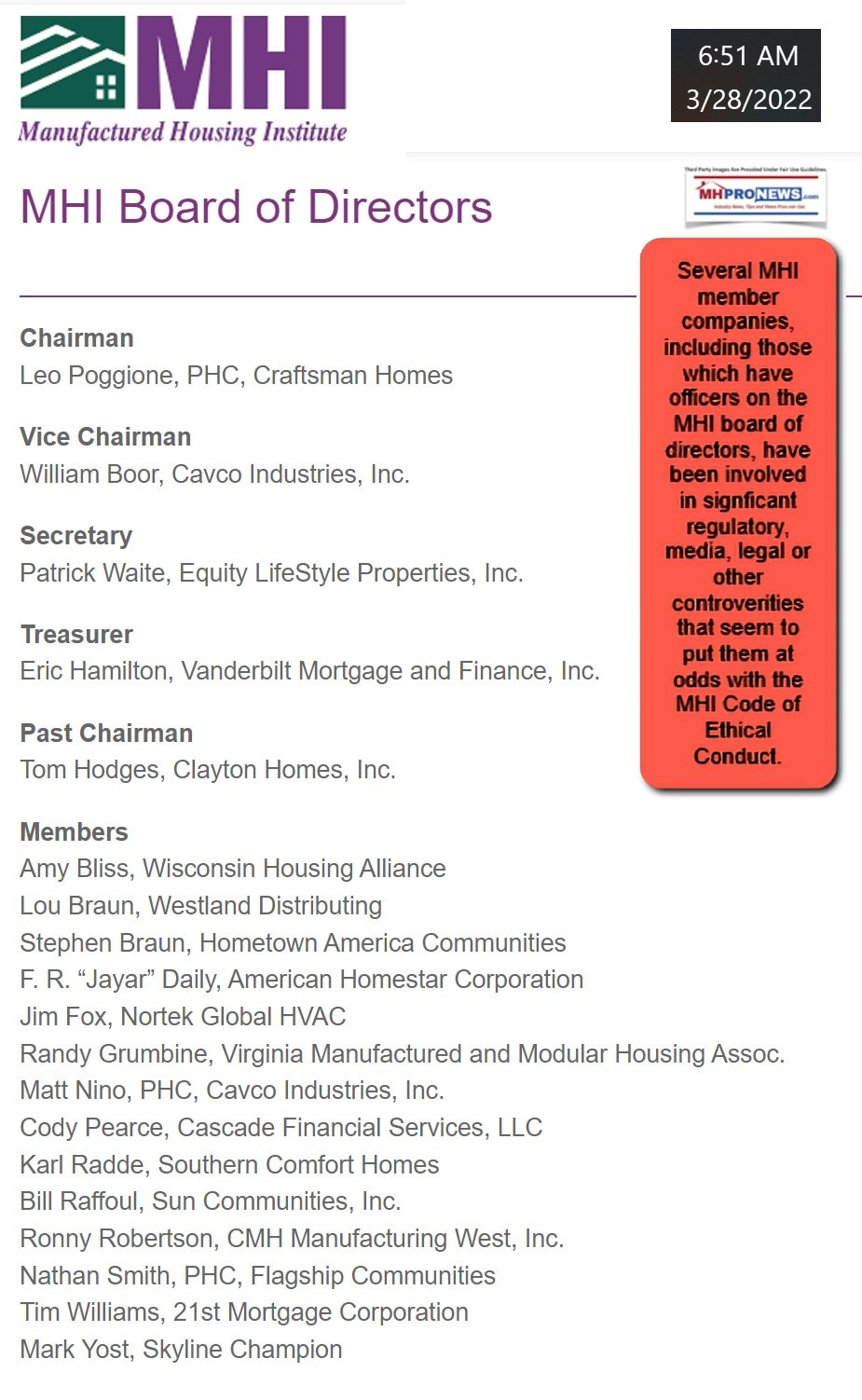
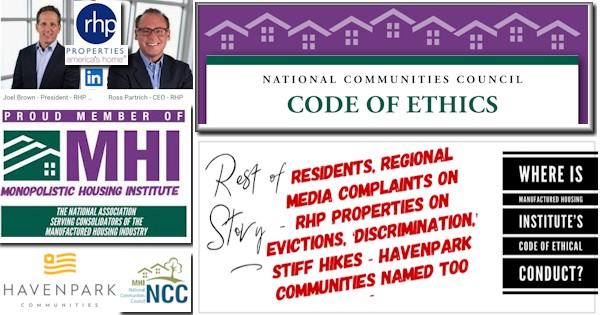
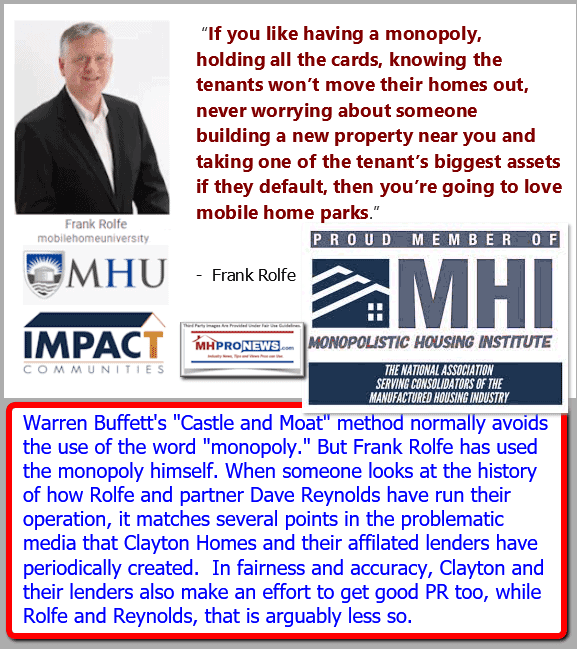
- 7) Then, there the following insight from Sun Communities (SUI) corporate leader Gary Shiffman.
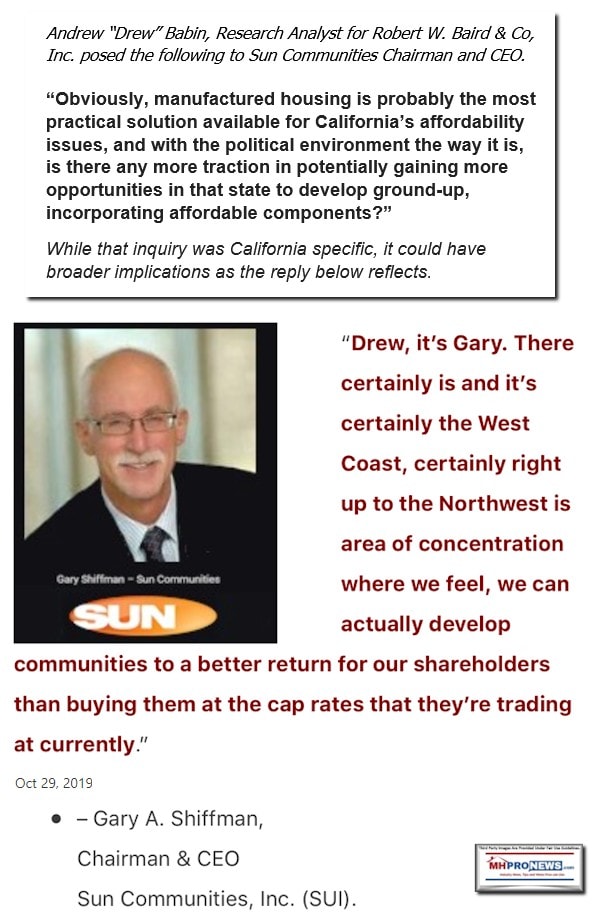
If that statement is true for Shiffman/Sun (SUI), then that’s likely as true for ELS too. Indeed, the point made by ELS that they are developing sites suggests as much. That also harkens back to the MHI/zoning “Postscript” portion of yesterday’s report. Failing to exercise the opportunities made possible by current federal laws under the Manufactured Housing Improvement Act (MHIA) of 2000, or Housing and Economic Recovery Act (HERA) of 2008, are just two possible examples of how shareholders and affordable housing seekers alike could benefit more. ELS’s general public silence on these matters may be legally problematic.
- 8) Speaking of legally problematic, ELS is no stranger to litigation aimed against their firm. ELS told MHProNews that they are demonstrably willing and able to use the courts to defend what they believe are their interests. See how they said that at in their own words as stated by Sam Zell, linked here. Note that Zell ripped the industry’s lack of competitive financing, one of the points made anew by ELS management in their corporate disclosures above.
There is more than could be unpacked from these ELS statements and disclosures. But that’s sufficient to make this point. There seems to be healthy doses of what the Capital Research Center has dubbed “deception and misdirection” at play in MHVille. This sheds light on the manufactured home industry’s underperformance. It also sheds light on the fact that there are thousands of fewer communities now than at the turn of the century.

See what the Lincoln Land Institute’s George W. “Mac” McCarthy said on that topic.
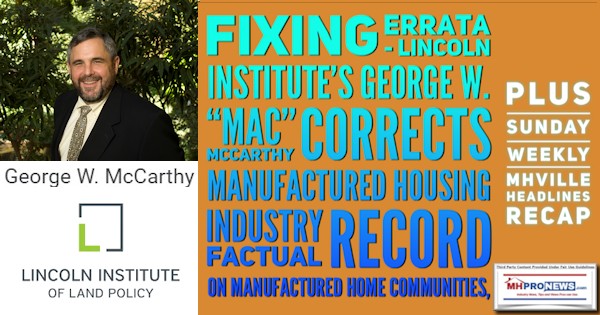
These are some of the insights that are not found in either official corporate pronouncements, nor in the typically glowing analysis that comes from all too many in or beyond MHVille. To learn more dig deeper into the linked reports.
In conclusion, the case can be made that it will be increasingly difficult for ‘insiders’ at MHI to make statements that don’t to some degree reveal – to informed eyes and minds – the market manipulation that has apparently befallen manufactured housing in the 21st century. MHVille – our warm term for the arguably artificially diminutive, manufactured home industry – is smaller than it was in 1998 in numbers of communities, production, retail locations, sales, lenders, suppliers, and more. These facts cry out for Congressional oversight, objective vs. politicized federal exploration, state-level antitrust probes, as well as possible litigation by class action attorneys acting on behalf of shareholders and the thousands of potential community residents, harmed independents, and perhaps other classes too. A few profit by exploiting what they see as market weaknesses in ways that act as barriers of entry when the affordable housing crisis demands a maximum effort that could benefit millions. ###
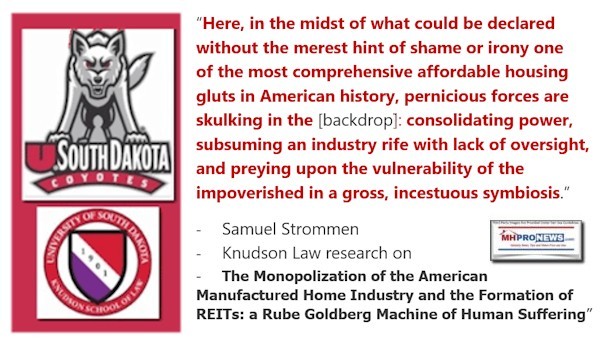

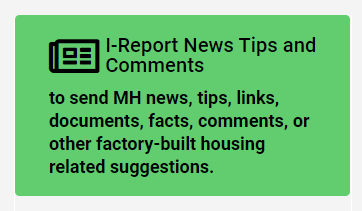
Again, our thanks to free email subscribers and all readers like you, our tipsters/sources, sponsors and God for making and keeping us the runaway number one source for authentic “News through the lens of manufactured homes and factory-built housing” © where “We Provide, You Decide.” © ## (Affordable housing, manufactured homes, reports, fact-checks, analysis, and commentary. Third-party images or content are provided under fair use guidelines for media.) (See Related Reports, further below. Text/image boxes often are hot-linked to other reports that can be access by clicking on them.)

By L.A. “Tony” Kovach – for MHProNews.com.
Tony earned a journalism scholarship and earned numerous awards in history and in manufactured housing.
For example, he earned the prestigious Lottinville Award in history from the University of Oklahoma, where he studied history and business management. He’s a managing member and co-founder of LifeStyle Factory Homes, LLC, the parent company to MHProNews, and MHLivingNews.com.
This article reflects the LLC’s and/or the writer’s position, and may or may not reflect the views of sponsors or supporters.
Connect on LinkedIn: http://www.linkedin.com/in/latonykovach
Related References:
The text/image boxes below are linked to other reports, which can be accessed by clicking on them.
